👆 View a 3-minute video on how to use the Digital Learning Curriculum in your classroom.
Digital Skills Curriculum for Primary Schools
Our curriculum supports the development of critical digital skills such as coding and robotics, preparing students for the future and fostering their growth as engaged, global digital citizens.
- From Junior Infants to 6th Class
- Teacher guides & lesson plans
- Aligned with the STEE Primary Curriculum Framework
Trusted by Hundreds of Irish Schools
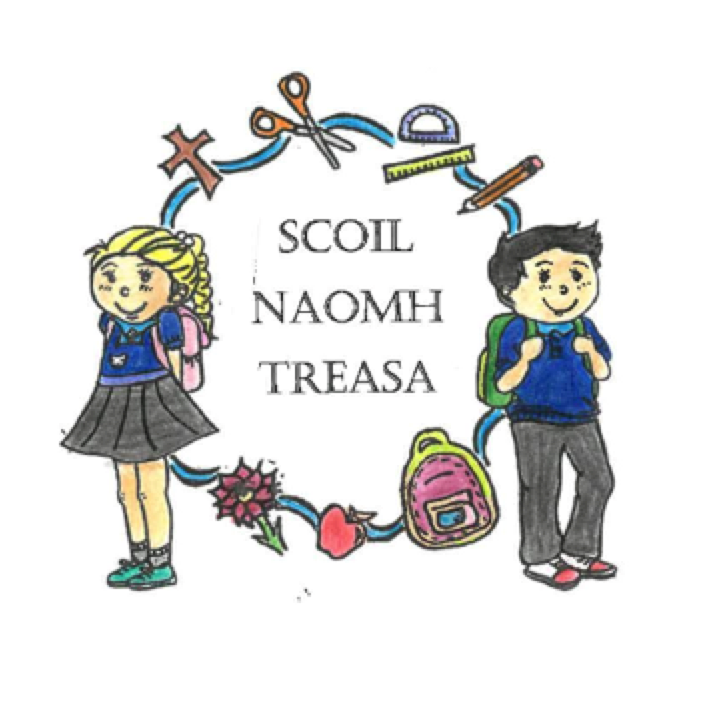
Ballyroe Central Ns
Kildare
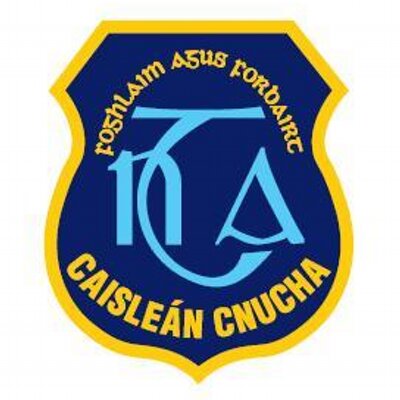
Scoil Thomais
Dublin

Camolin NS
Wexford
.jpg)
Robertson NS
Donegal

Scoil Raifteiri
Mayo
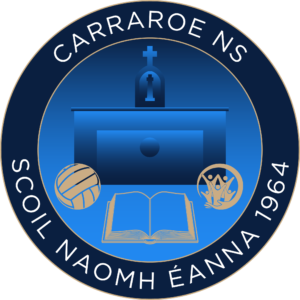
Carraroe NS
Sligo
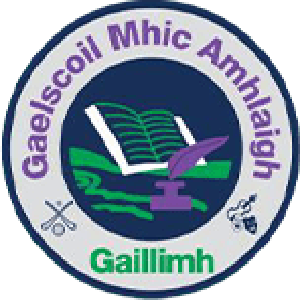
Gaelscoil Mhic Amhlaigh
Galway
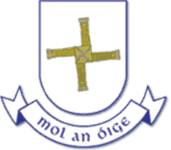
Scoil Bhride NS
Laois
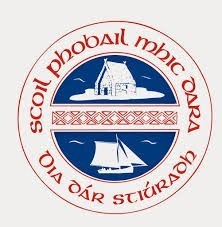
Scoil Mhic Dara
Galway
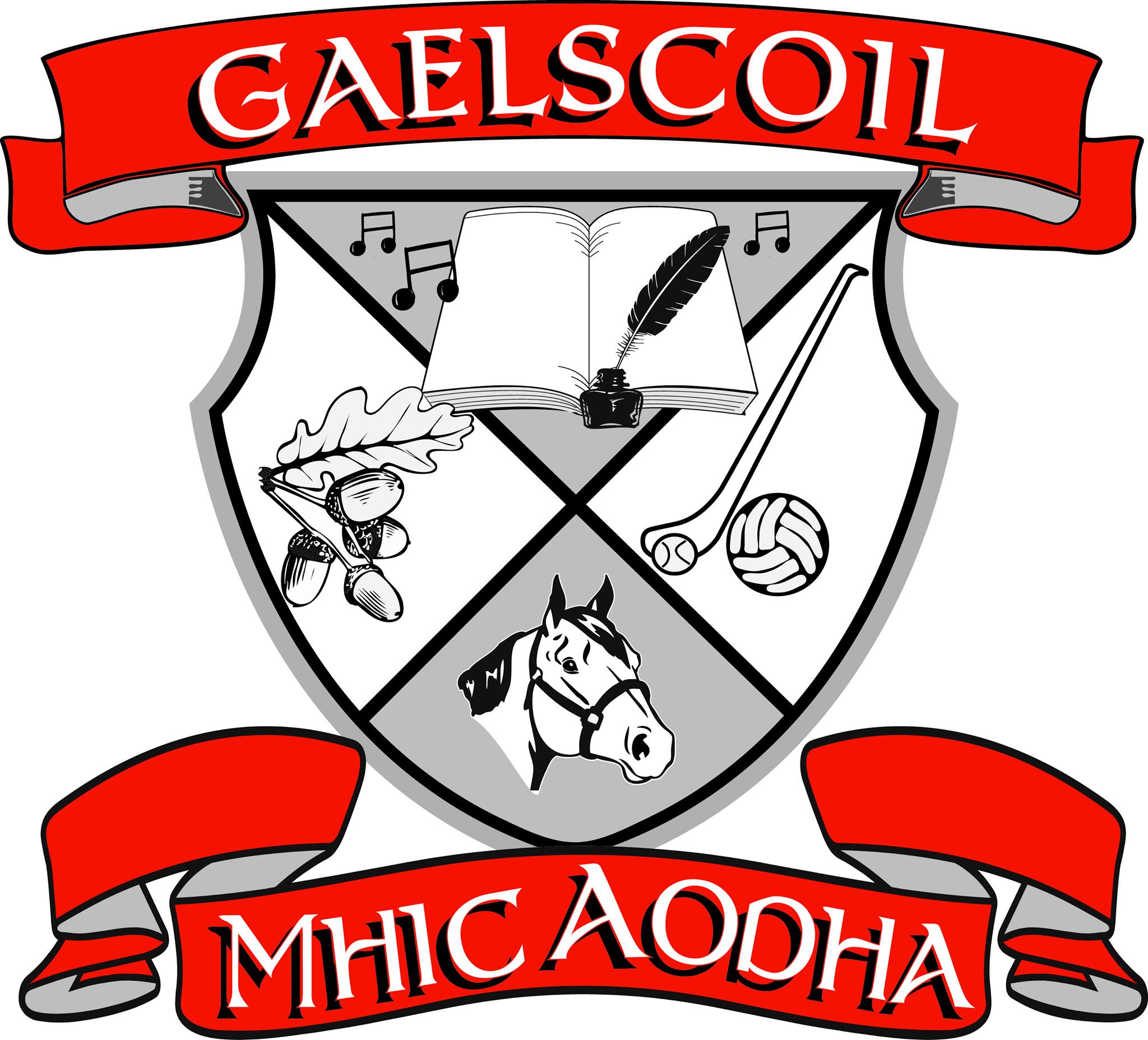
Gaelscoil Mhic Aodha
Kildare

Carndonagh Boys NS
Donegal

St Fergus Primary School
Limerick
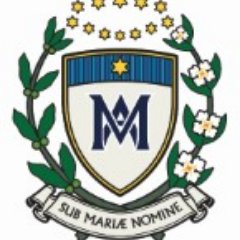
Holy Family N.S.
Sligo
.png)
Kilcoole Primary School
Wicklow
.png)
Gaelscoil Inis Corthaidh
Wexford
.png)
Gaelscoil Durlas
Tipperary

Letterkenny Educate Together
Donegal
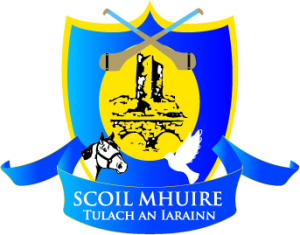
Tallow NS
Waterford
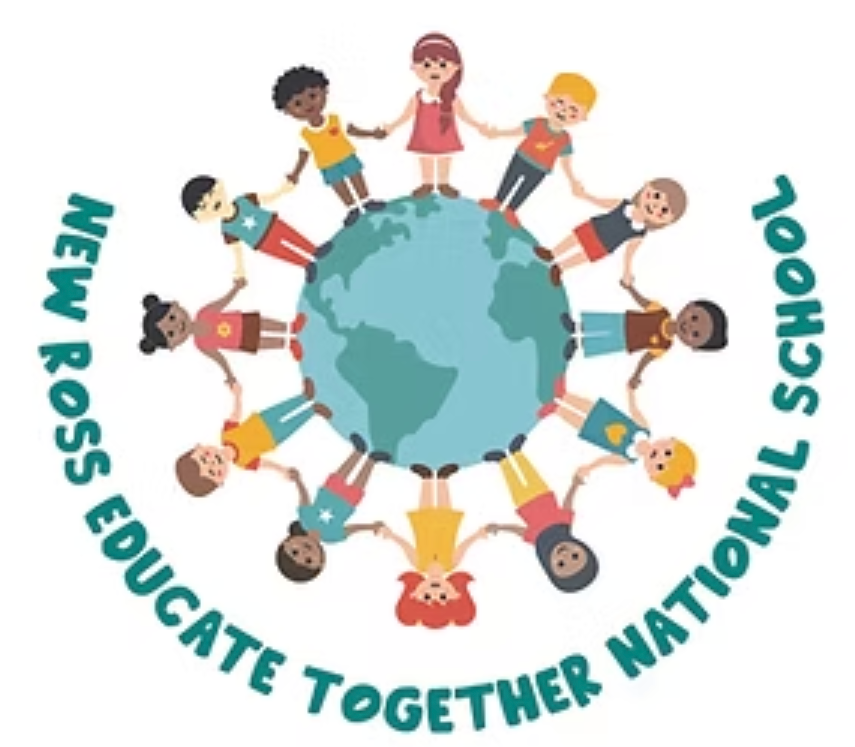
New Ross Educate Together National School
Wexford
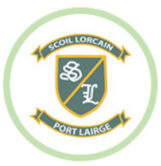
Scoil Lorcain B.N.S.
Waterford

Lower Glanmire NS
Cork
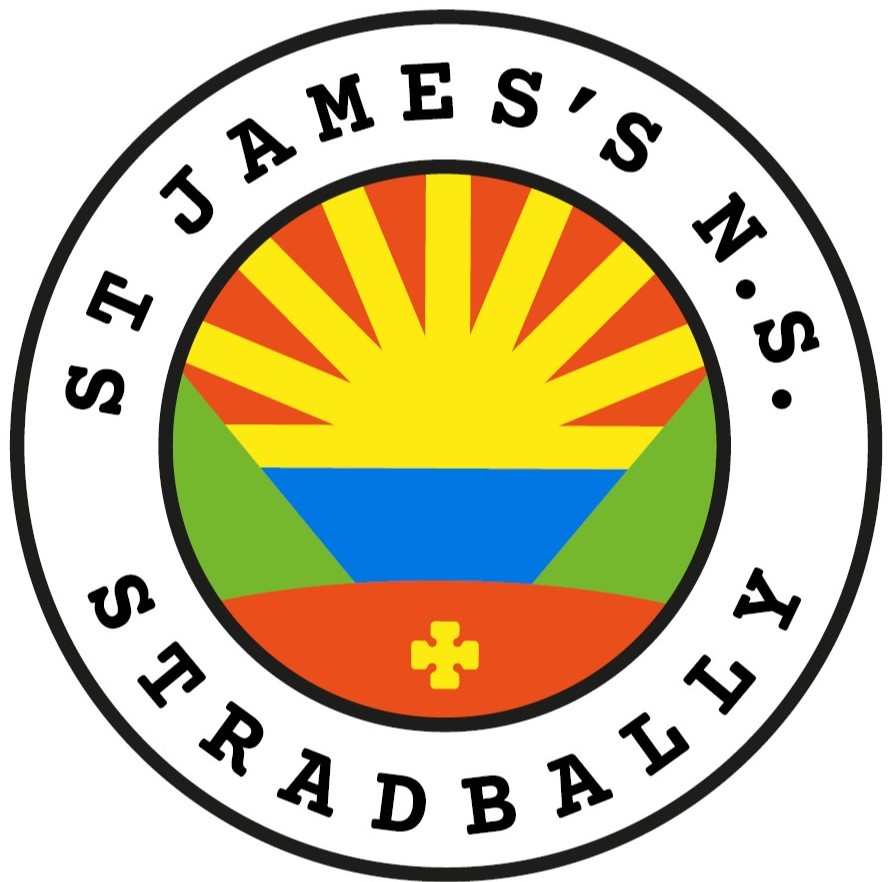
St James's NS
Waterford

St Josephs NS
Louth
.png)
St Baithins NS
Donegal
.png)
Dangan Mxd Ns
Meath
.png)
St John's SNS
Wicklow
.png)
Tseachtar Laoch NS
Dublin
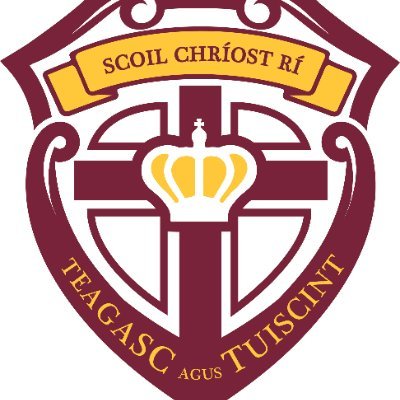
Christ The King BNS
Limerick
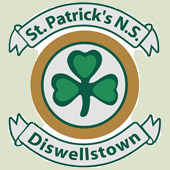
St Patricks NS
Dublin
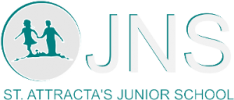
St Attractas Junior NS
Dublin
Four Key Elements for Science, Technology and Engineering Education
Exploring & understanding
Collaboration, Curiosity, Discovery
Creative & critical thinking
Play, Innovation, Risk-taking
Problem-Solving & applying
Collaboration, Creativity, Resilience
Evaluating & communicating
Analysis, Communication, Feedback
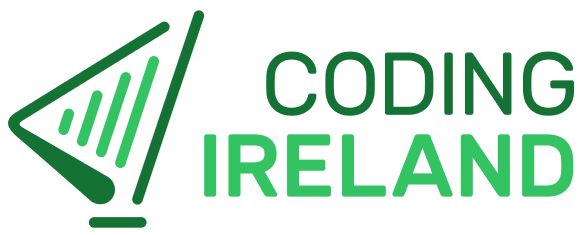
Digital Skills Curriculum
2024/25 Edition€9 per student, includes student access & teacher resources.
Get started for 2024/25 View a quick 3 min video Info Sheet FAQsDigital Skills Curriculum
Junior Infants
Module 1
Exploring Patterns
Explore patterns hands-on with unplugged coding fun!
Lesson Equipment
Students will need to use the following equipment and can share if necessary.
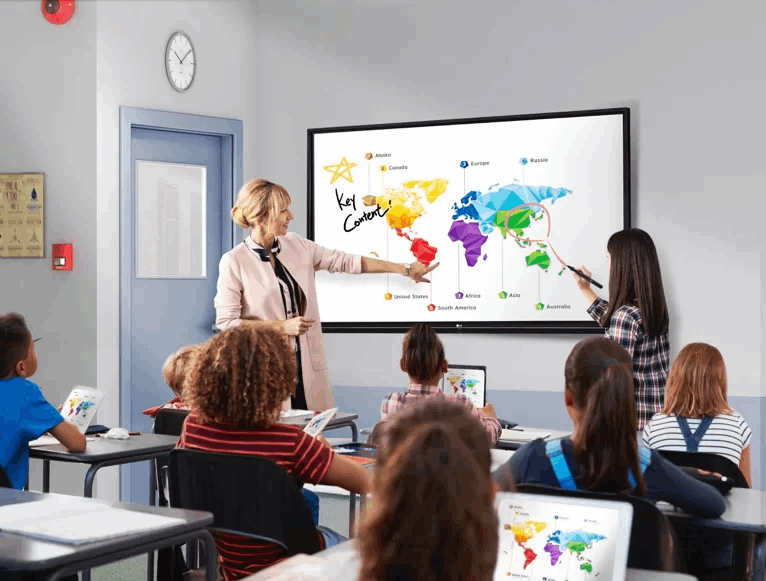
A teacher interactive display is a device that allows teachers and students to interact with digital content on a large screen. It can be used for various purposes, such as presenting, annotating, collaborating, and engaging in interactive learning activities. Some examples of teacher interactive displays are SMART Board1, Clevertouch2, and Epson3. These displays have different features and specifications, such as touch sensitivity, embedded computing, software compatibility, and screen size. Teacher interactive displays can enhance the teaching and learning experience by making it more dynamic, collaborative, and fun.

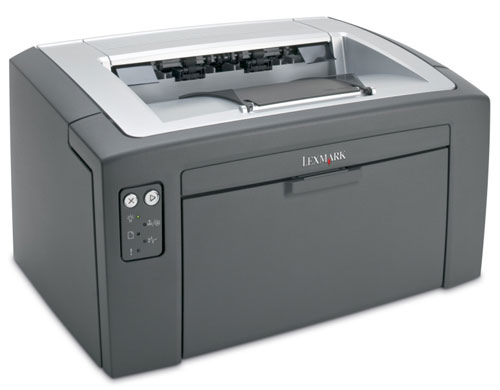
If a printer has been listed as equipment required for a lesson then it's necessary to print out some handouts or work sheets for the lesson.
Coding Ireland can provide full classroom kits, please provide student numbers to get a quote.
Module 2
.png)
My First Steps in Digital Storytelling
Create Fun Stories and Simple Adventures in Scratch Jr!
Lesson Equipment
Students will need to use the following equipment and can share if necessary.

iPads and tablets are versatile, portable computing devices that offer a wide range of educational applications in the classroom. Featuring touch-sensitive screens ranging from 7 to 13 inches, these devices allow students and teachers to interact directly with content through touch, swipe, and voice commands.
Coding Ireland can provide full classroom kits, please provide student numbers to get a quote.
Module 3

Journey into Robotic Movements
Code robot movements with fun BeeBot adventures!
Lesson Equipment
Students will need to use the following equipment and can share if necessary.

The Bee-Bot is a child-friendly, programmable robot designed to introduce young students to basic programming concepts, including sequencing and problem-solving. This bee-shaped robot measures approximately 13 cm by 10 cm, featuring a simple interface with directional buttons to input commands for movement.
Capable of remembering up to 40 commands, Bee-Bot can move in 15 cm steps and turn 90 degrees, ideal for executing planned sequences. Its durable, colourful design and rechargeable battery via USB make it both classroom-friendly and easy to maintain. Teachers can use Bee-Bots with various thematic mats and accessories to enhance learning across different subjects, promoting creativity and teamwork among students.
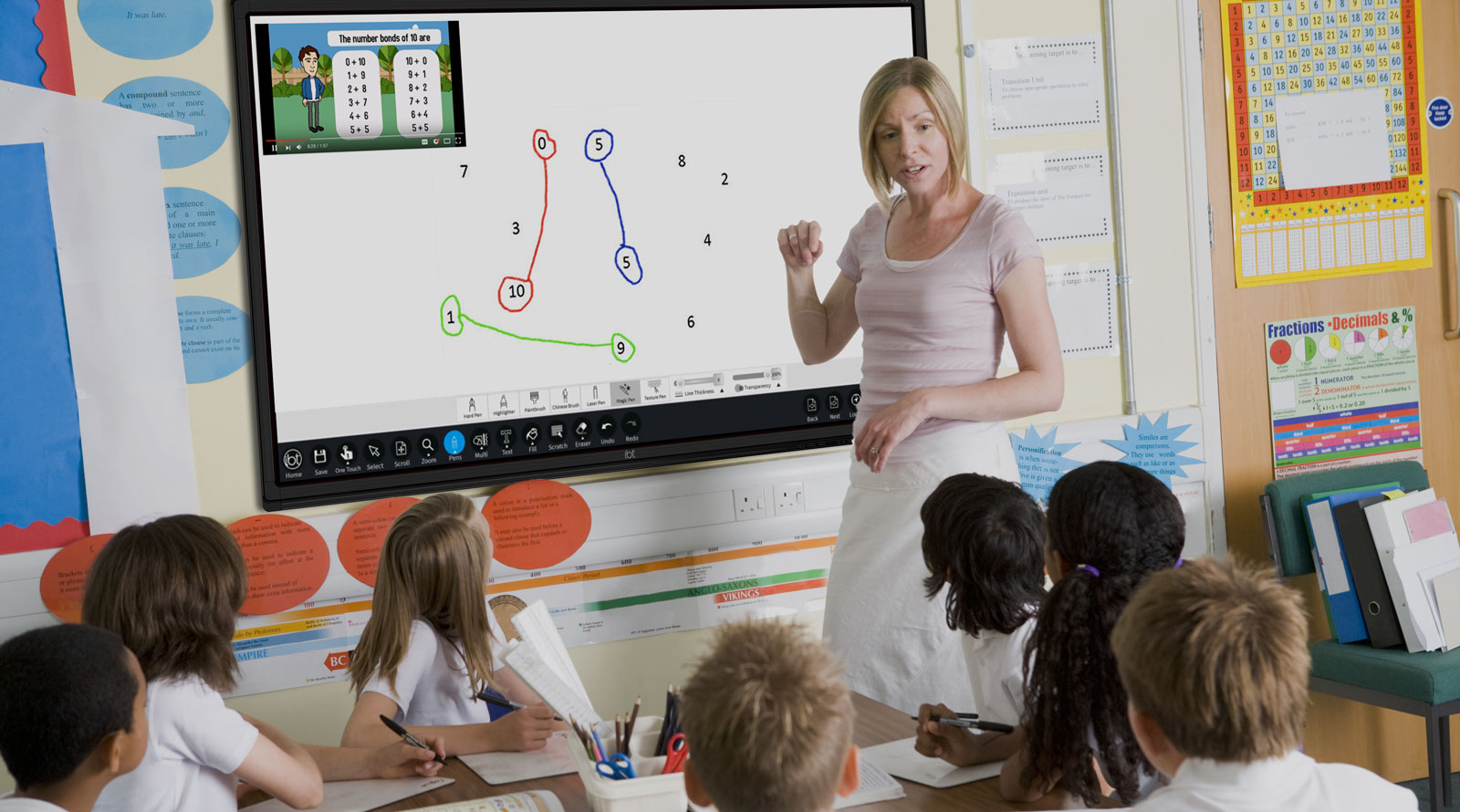
If a project/large screen has been listed as equipment required for a lesson then it's necessary as part of the lesson to display or demonstrate something to the students.
This can be done using:
- a projector
- an interactive whiteboard
- a large monitor/TV
Coding Ireland can provide full classroom kits, please provide student numbers to get a quote.
Senior Infants
Module 1

Solving Problems
Coding Without Screens, Explore Patterns Hands-On!
Lesson Equipment
Students will need to use the following equipment and can share if necessary.

A teacher interactive display is a device that allows teachers and students to interact with digital content on a large screen. It can be used for various purposes, such as presenting, annotating, collaborating, and engaging in interactive learning activities. Some examples of teacher interactive displays are SMART Board1, Clevertouch2, and Epson3. These displays have different features and specifications, such as touch sensitivity, embedded computing, software compatibility, and screen size. Teacher interactive displays can enhance the teaching and learning experience by making it more dynamic, collaborative, and fun.

If a printer has been listed as equipment required for a lesson then it's necessary to print out some handouts or work sheets for the lesson.
Coding Ireland can provide full classroom kits, please provide student numbers to get a quote.
Module 2
.png)
Creative Stories
Junior Creators Emerge with Scratch Jr.
Lesson Equipment
Students will need to use the following equipment and can share if necessary.

iPads and tablets are versatile, portable computing devices that offer a wide range of educational applications in the classroom. Featuring touch-sensitive screens ranging from 7 to 13 inches, these devices allow students and teachers to interact directly with content through touch, swipe, and voice commands.
Coding Ireland can provide full classroom kits, please provide student numbers to get a quote.
Module 3

Exploring Robotics and Commands
Becoming Robot Programmers: BeeBots Take on New Challenges!
Lesson Equipment
Students will need to use the following equipment and can share if necessary.

The Bee-Bot is a child-friendly, programmable robot designed to introduce young students to basic programming concepts, including sequencing and problem-solving. This bee-shaped robot measures approximately 13 cm by 10 cm, featuring a simple interface with directional buttons to input commands for movement.
Capable of remembering up to 40 commands, Bee-Bot can move in 15 cm steps and turn 90 degrees, ideal for executing planned sequences. Its durable, colourful design and rechargeable battery via USB make it both classroom-friendly and easy to maintain. Teachers can use Bee-Bots with various thematic mats and accessories to enhance learning across different subjects, promoting creativity and teamwork among students.
Coding Ireland can provide full classroom kits, please provide student numbers to get a quote.
1st Class
Module 1

The World of Logic
Build a Solid Base with Unplugged Coding Lessons
Lesson Equipment
Students will need to use the following equipment and can share if necessary.

A teacher interactive display is a device that allows teachers and students to interact with digital content on a large screen. It can be used for various purposes, such as presenting, annotating, collaborating, and engaging in interactive learning activities. Some examples of teacher interactive displays are SMART Board1, Clevertouch2, and Epson3. These displays have different features and specifications, such as touch sensitivity, embedded computing, software compatibility, and screen size. Teacher interactive displays can enhance the teaching and learning experience by making it more dynamic, collaborative, and fun.


If a printer has been listed as equipment required for a lesson then it's necessary to print out some handouts or work sheets for the lesson.
Coding Ireland can provide full classroom kits, please provide student numbers to get a quote.
Module 2
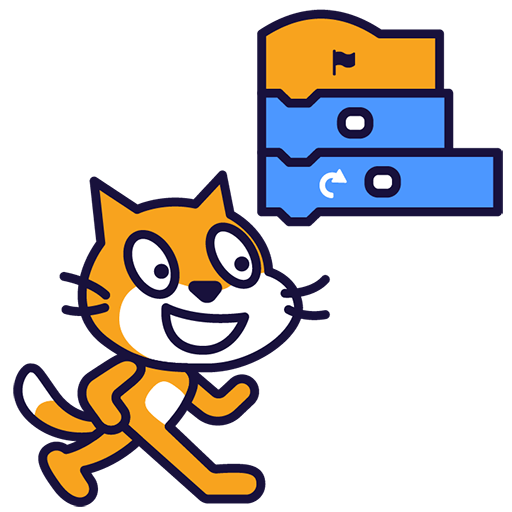
Adventures in Digital Creation
Bring Your Ideas to Life with Scratch Jr!
Lesson Equipment
Students will need to use the following equipment and can share if necessary.

iPads and tablets are versatile, portable computing devices that offer a wide range of educational applications in the classroom. Featuring touch-sensitive screens ranging from 7 to 13 inches, these devices allow students and teachers to interact directly with content through touch, swipe, and voice commands.
Coding Ireland can provide full classroom kits, please provide student numbers to get a quote.
Module 3
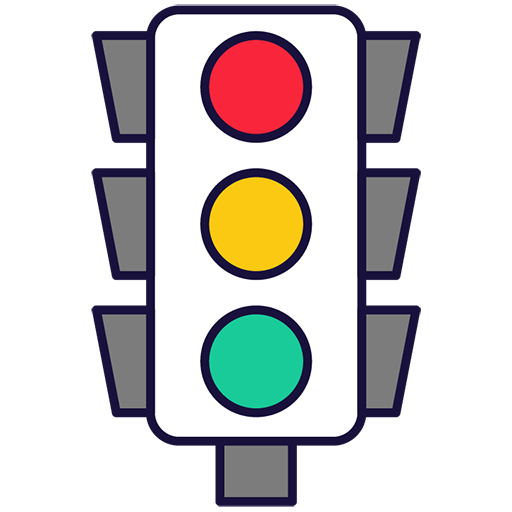
Electricity and Simple Circuits
Explore Electricity in Action by Building Real-World Circuits!
Lesson Equipment
Students will need to use the following equipment and can share if necessary.
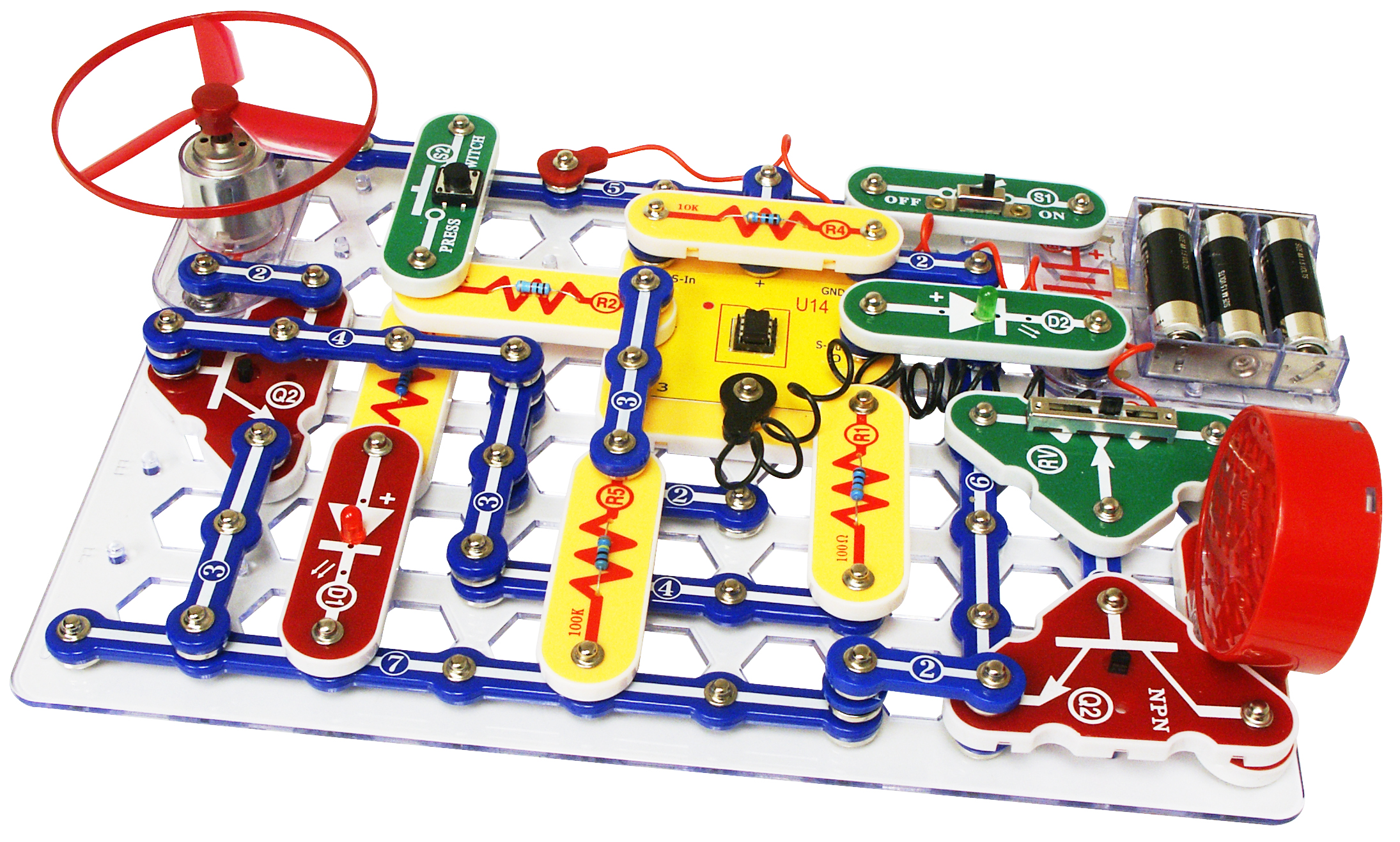
Snap Circuits are hands-on learning kits designed to teach students about electronics and circuit design in an intuitive and interactive way. These kits consist of various electronic components like resistors, switches, motors, and speakers that snap together on a plastic grid—no soldering required.
Each kit comes with easy-to-follow instructions that guide students through the construction of working circuits to create projects like radios, alarms, and doorbells. This practical approach helps students understand the basics of electrical circuits and the functionality of different components by seeing and modifying the circuits they build.
Snap Circuits are durable, reusable, and expandable, making them an ideal resource for classroom settings. They foster critical thinking, problem-solving, and creativity, providing a foundational understanding of electrical engineering concepts through engaging, real-world applications.
Coding Ireland can provide full classroom kits, please provide student numbers to get a quote.
2nd Class
Introduction Module
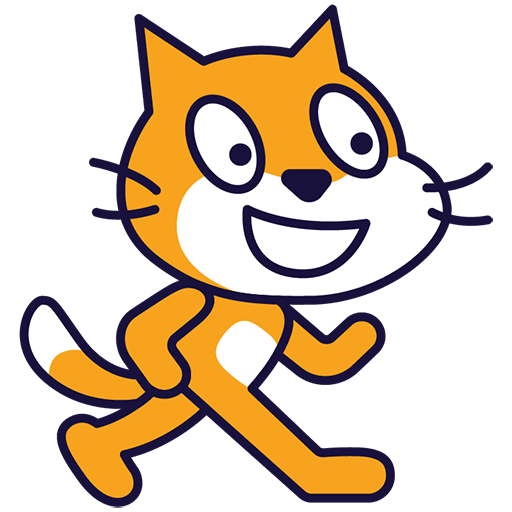
My First Coding Adventure
Start your coding journey with fun and simple projects!
Student Devices
To do this module, students will need to use either of these devices:
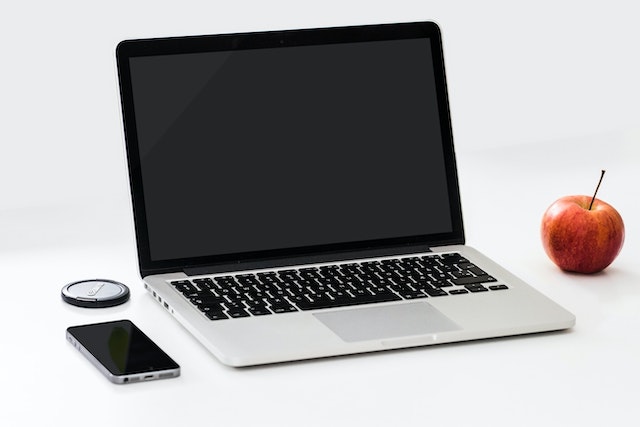 Chromebooks, laptops, and PCs are crucial tools for coding and digital skills education. Chromebooks are ideal for web-based applications and collaborative projects, while laptops and PCs support a wider range of programming environments and software for more intensive tasks like software development and data analysis.
Chromebooks, laptops, and PCs are crucial tools for coding and digital skills education. Chromebooks are ideal for web-based applications and collaborative projects, while laptops and PCs support a wider range of programming environments and software for more intensive tasks like software development and data analysis.Equipped with full keyboards and the ability to run specialized coding software, these devices enable students to learn programming languages, debug code, and understand software architecture. Their versatility supports both individual learning and group projects, making them indispensable for developing critical digital and computational thinking skills in the classroom.

iPads and tablets are versatile, portable computing devices that offer a wide range of educational applications in the classroom. Featuring touch-sensitive screens ranging from 7 to 13 inches, these devices allow students and teachers to interact directly with content through touch, swipe, and voice commands.
If necessary, students can work in groups (ideally in a group of 2 or 3 students) and use one device between them.
Module 1

Exploring Coding
Coding Made Easy: Drag & Drop Fun with Coding Blocks!
Student Devices
To do this module, students will need to use either of these devices:
 Chromebooks, laptops, and PCs are crucial tools for coding and digital skills education. Chromebooks are ideal for web-based applications and collaborative projects, while laptops and PCs support a wider range of programming environments and software for more intensive tasks like software development and data analysis.
Chromebooks, laptops, and PCs are crucial tools for coding and digital skills education. Chromebooks are ideal for web-based applications and collaborative projects, while laptops and PCs support a wider range of programming environments and software for more intensive tasks like software development and data analysis.Equipped with full keyboards and the ability to run specialized coding software, these devices enable students to learn programming languages, debug code, and understand software architecture. Their versatility supports both individual learning and group projects, making them indispensable for developing critical digital and computational thinking skills in the classroom.

iPads and tablets are versatile, portable computing devices that offer a wide range of educational applications in the classroom. Featuring touch-sensitive screens ranging from 7 to 13 inches, these devices allow students and teachers to interact directly with content through touch, swipe, and voice commands.
If necessary, students can work in groups (ideally in a group of 2 or 3 students) and use one device between them.
Module 2
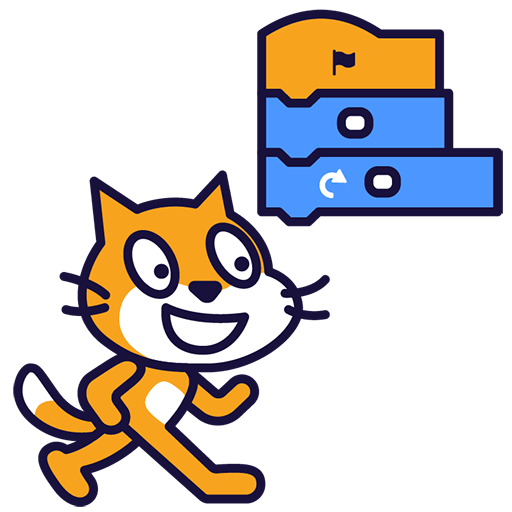
Creative Coding Challenges
Level Up with Block-Based Challenges!
Lesson Equipment
Students will need to use the following equipment and can share if necessary.
 Chromebooks, laptops, and PCs are crucial tools for coding and digital skills education. Chromebooks are ideal for web-based applications and collaborative projects, while laptops and PCs support a wider range of programming environments and software for more intensive tasks like software development and data analysis.
Chromebooks, laptops, and PCs are crucial tools for coding and digital skills education. Chromebooks are ideal for web-based applications and collaborative projects, while laptops and PCs support a wider range of programming environments and software for more intensive tasks like software development and data analysis.Equipped with full keyboards and the ability to run specialized coding software, these devices enable students to learn programming languages, debug code, and understand software architecture. Their versatility supports both individual learning and group projects, making them indispensable for developing critical digital and computational thinking skills in the classroom.

iPads and tablets are versatile, portable computing devices that offer a wide range of educational applications in the classroom. Featuring touch-sensitive screens ranging from 7 to 13 inches, these devices allow students and teachers to interact directly with content through touch, swipe, and voice commands.
Coding Ireland can provide full classroom kits, please provide student numbers to get a quote.
Module 3
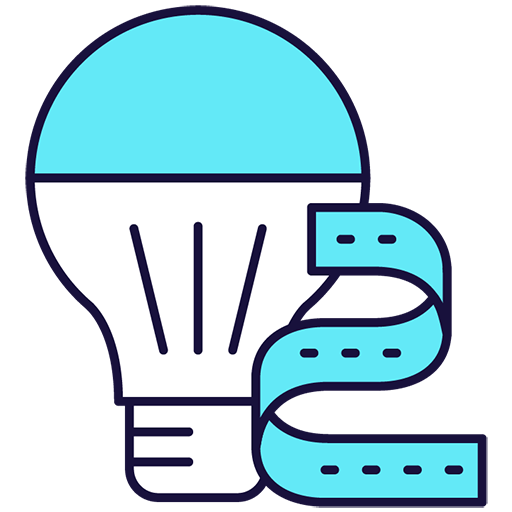
Discovering the Magic of Circuits
From Simple to Sparks, build exciting circuits in the classroom
Lesson Equipment
Students will need to use the following equipment and can share if necessary.

Snap Circuits are hands-on learning kits designed to teach students about electronics and circuit design in an intuitive and interactive way. These kits consist of various electronic components like resistors, switches, motors, and speakers that snap together on a plastic grid—no soldering required.
Each kit comes with easy-to-follow instructions that guide students through the construction of working circuits to create projects like radios, alarms, and doorbells. This practical approach helps students understand the basics of electrical circuits and the functionality of different components by seeing and modifying the circuits they build.
Snap Circuits are durable, reusable, and expandable, making them an ideal resource for classroom settings. They foster critical thinking, problem-solving, and creativity, providing a foundational understanding of electrical engineering concepts through engaging, real-world applications.
Coding Ireland can provide full classroom kits, please provide student numbers to get a quote.
3rd Class
Introduction Module

My First Coding Adventure
Start your coding journey with fun and simple projects!
Student Devices
To do this module, students will need to use either of these devices:
 Chromebooks, laptops, and PCs are crucial tools for coding and digital skills education. Chromebooks are ideal for web-based applications and collaborative projects, while laptops and PCs support a wider range of programming environments and software for more intensive tasks like software development and data analysis.
Chromebooks, laptops, and PCs are crucial tools for coding and digital skills education. Chromebooks are ideal for web-based applications and collaborative projects, while laptops and PCs support a wider range of programming environments and software for more intensive tasks like software development and data analysis.Equipped with full keyboards and the ability to run specialized coding software, these devices enable students to learn programming languages, debug code, and understand software architecture. Their versatility supports both individual learning and group projects, making them indispensable for developing critical digital and computational thinking skills in the classroom.

iPads and tablets are versatile, portable computing devices that offer a wide range of educational applications in the classroom. Featuring touch-sensitive screens ranging from 7 to 13 inches, these devices allow students and teachers to interact directly with content through touch, swipe, and voice commands.
If necessary, students can work in groups (ideally in a group of 2 or 3 students) and use one device between them.
Module 1
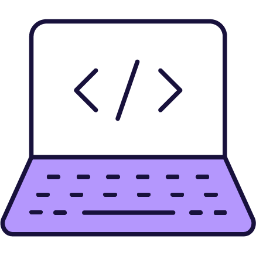
Coding and Creative Projects
Create Games and Animations with Block Based Coding
Student Devices
To do this module, students will need to use either of these devices:
 Chromebooks, laptops, and PCs are crucial tools for coding and digital skills education. Chromebooks are ideal for web-based applications and collaborative projects, while laptops and PCs support a wider range of programming environments and software for more intensive tasks like software development and data analysis.
Chromebooks, laptops, and PCs are crucial tools for coding and digital skills education. Chromebooks are ideal for web-based applications and collaborative projects, while laptops and PCs support a wider range of programming environments and software for more intensive tasks like software development and data analysis.Equipped with full keyboards and the ability to run specialized coding software, these devices enable students to learn programming languages, debug code, and understand software architecture. Their versatility supports both individual learning and group projects, making them indispensable for developing critical digital and computational thinking skills in the classroom.

iPads and tablets are versatile, portable computing devices that offer a wide range of educational applications in the classroom. Featuring touch-sensitive screens ranging from 7 to 13 inches, these devices allow students and teachers to interact directly with content through touch, swipe, and voice commands.
If necessary, students can work in groups (ideally in a group of 2 or 3 students) and use one device between them.
Module 2
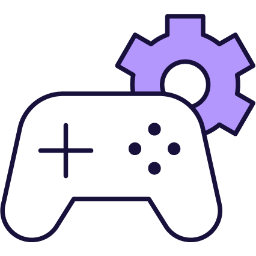
Introduction to Game Design
Level Up and Code Your Own Arcade Games!
Student Devices
To do this module, students will need to use either of these devices:
 Chromebooks, laptops, and PCs are crucial tools for coding and digital skills education. Chromebooks are ideal for web-based applications and collaborative projects, while laptops and PCs support a wider range of programming environments and software for more intensive tasks like software development and data analysis.
Chromebooks, laptops, and PCs are crucial tools for coding and digital skills education. Chromebooks are ideal for web-based applications and collaborative projects, while laptops and PCs support a wider range of programming environments and software for more intensive tasks like software development and data analysis.Equipped with full keyboards and the ability to run specialized coding software, these devices enable students to learn programming languages, debug code, and understand software architecture. Their versatility supports both individual learning and group projects, making them indispensable for developing critical digital and computational thinking skills in the classroom.

iPads and tablets are versatile, portable computing devices that offer a wide range of educational applications in the classroom. Featuring touch-sensitive screens ranging from 7 to 13 inches, these devices allow students and teachers to interact directly with content through touch, swipe, and voice commands.
If necessary, students can work in groups (ideally in a group of 2 or 3 students) and use one device between them.
Module 3
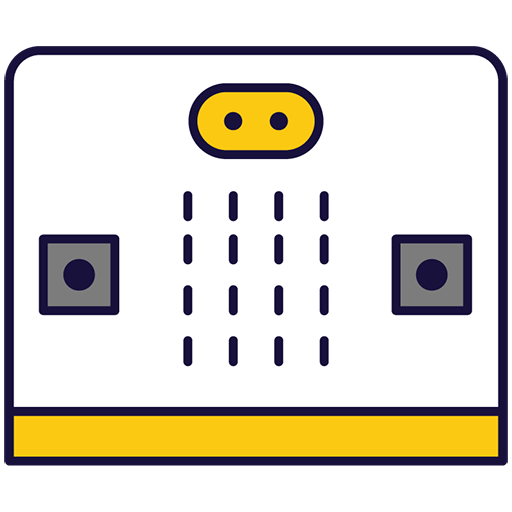
Microbit Basics
Introduction to microbits: coding simple interactions
Student Devices
To do this module, students will need to use either of these devices:
 Chromebooks, laptops, and PCs are crucial tools for coding and digital skills education. Chromebooks are ideal for web-based applications and collaborative projects, while laptops and PCs support a wider range of programming environments and software for more intensive tasks like software development and data analysis.
Chromebooks, laptops, and PCs are crucial tools for coding and digital skills education. Chromebooks are ideal for web-based applications and collaborative projects, while laptops and PCs support a wider range of programming environments and software for more intensive tasks like software development and data analysis.Equipped with full keyboards and the ability to run specialized coding software, these devices enable students to learn programming languages, debug code, and understand software architecture. Their versatility supports both individual learning and group projects, making them indispensable for developing critical digital and computational thinking skills in the classroom.
If necessary, students can work in groups (ideally in a group of 2 or 3 students) and use one device between them.
Lesson Equipment
Students will need to use the following equipment and can share if necessary.

The BBC microbit is a pocket-sized codeable computer with motion detection, a built-in compass and Bluetooth technology.
The board measures 4 cm × 5 cm and has a processor, accelerometer and magnetometer sensors, Bluetooth and USB connectivity, a display consisting of 25 LEDs, two programmable buttons, and can be powered by either USB or an external battery pack.
The list of things you can program the Microbit to do is nearly endless. You can program the buttons, LEDs and different sensors to create games and turn the Microbit into things like a pedometer, a compass or even a musical instrument.
Coding Ireland can provide full classroom kits, please provide student numbers to get a quote.
4th Class
Introduction Module
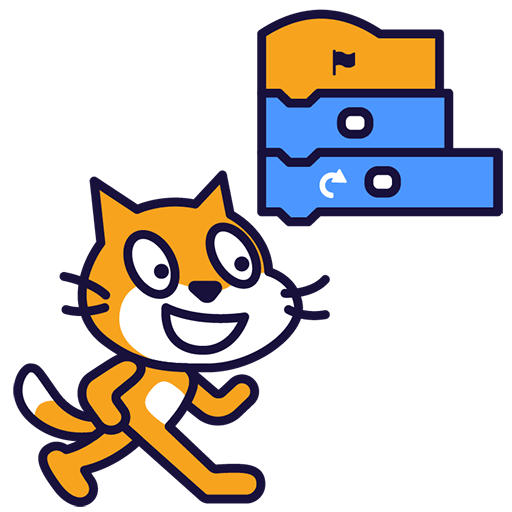
Introduction to Coding
Beginner's Gateway to Coding
Student Devices
To do this module, students will need to use either of these devices:
 Chromebooks, laptops, and PCs are crucial tools for coding and digital skills education. Chromebooks are ideal for web-based applications and collaborative projects, while laptops and PCs support a wider range of programming environments and software for more intensive tasks like software development and data analysis.
Chromebooks, laptops, and PCs are crucial tools for coding and digital skills education. Chromebooks are ideal for web-based applications and collaborative projects, while laptops and PCs support a wider range of programming environments and software for more intensive tasks like software development and data analysis.Equipped with full keyboards and the ability to run specialized coding software, these devices enable students to learn programming languages, debug code, and understand software architecture. Their versatility supports both individual learning and group projects, making them indispensable for developing critical digital and computational thinking skills in the classroom.

iPads and tablets are versatile, portable computing devices that offer a wide range of educational applications in the classroom. Featuring touch-sensitive screens ranging from 7 to 13 inches, these devices allow students and teachers to interact directly with content through touch, swipe, and voice commands.
If necessary, students can work in groups (ideally in a group of 2 or 3 students) and use one device between them.
Module 1
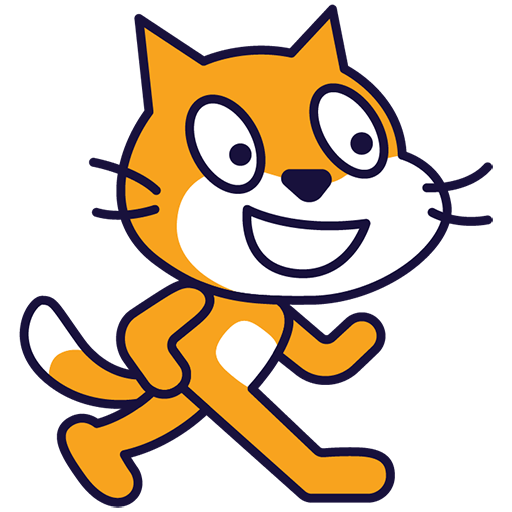
Dynamic Digital Projects
Design Interactive Stories and Games Through Coding
Student Devices
To do this module, students will need to use either of these devices:
 Chromebooks, laptops, and PCs are crucial tools for coding and digital skills education. Chromebooks are ideal for web-based applications and collaborative projects, while laptops and PCs support a wider range of programming environments and software for more intensive tasks like software development and data analysis.
Chromebooks, laptops, and PCs are crucial tools for coding and digital skills education. Chromebooks are ideal for web-based applications and collaborative projects, while laptops and PCs support a wider range of programming environments and software for more intensive tasks like software development and data analysis.Equipped with full keyboards and the ability to run specialized coding software, these devices enable students to learn programming languages, debug code, and understand software architecture. Their versatility supports both individual learning and group projects, making them indispensable for developing critical digital and computational thinking skills in the classroom.

iPads and tablets are versatile, portable computing devices that offer a wide range of educational applications in the classroom. Featuring touch-sensitive screens ranging from 7 to 13 inches, these devices allow students and teachers to interact directly with content through touch, swipe, and voice commands.
If necessary, students can work in groups (ideally in a group of 2 or 3 students) and use one device between them.
Module 2

Advanced Game Development
Make your own Games with MakeCode Arcade
Student Devices
To do this module, students will need to use either of these devices:
 Chromebooks, laptops, and PCs are crucial tools for coding and digital skills education. Chromebooks are ideal for web-based applications and collaborative projects, while laptops and PCs support a wider range of programming environments and software for more intensive tasks like software development and data analysis.
Chromebooks, laptops, and PCs are crucial tools for coding and digital skills education. Chromebooks are ideal for web-based applications and collaborative projects, while laptops and PCs support a wider range of programming environments and software for more intensive tasks like software development and data analysis.Equipped with full keyboards and the ability to run specialized coding software, these devices enable students to learn programming languages, debug code, and understand software architecture. Their versatility supports both individual learning and group projects, making them indispensable for developing critical digital and computational thinking skills in the classroom.

iPads and tablets are versatile, portable computing devices that offer a wide range of educational applications in the classroom. Featuring touch-sensitive screens ranging from 7 to 13 inches, these devices allow students and teachers to interact directly with content through touch, swipe, and voice commands.
If necessary, students can work in groups (ideally in a group of 2 or 3 students) and use one device between them.
Module 3
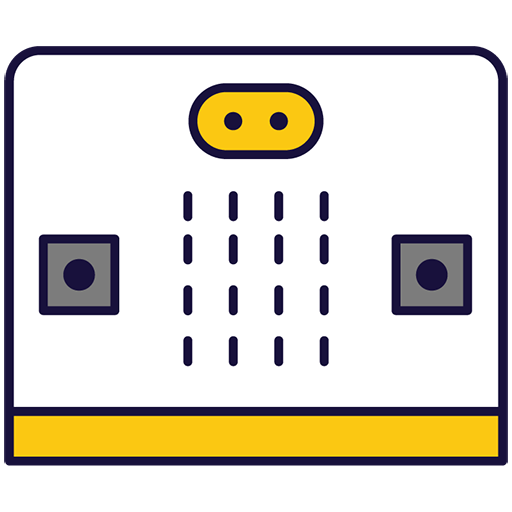
Microbit Adventures
Exploring creative projects with microbit technology
Student Devices
To do this module, students will need to use either of these devices:
 Chromebooks, laptops, and PCs are crucial tools for coding and digital skills education. Chromebooks are ideal for web-based applications and collaborative projects, while laptops and PCs support a wider range of programming environments and software for more intensive tasks like software development and data analysis.
Chromebooks, laptops, and PCs are crucial tools for coding and digital skills education. Chromebooks are ideal for web-based applications and collaborative projects, while laptops and PCs support a wider range of programming environments and software for more intensive tasks like software development and data analysis.Equipped with full keyboards and the ability to run specialized coding software, these devices enable students to learn programming languages, debug code, and understand software architecture. Their versatility supports both individual learning and group projects, making them indispensable for developing critical digital and computational thinking skills in the classroom.
If necessary, students can work in groups (ideally in a group of 2 or 3 students) and use one device between them.
Lesson Equipment
Students will need to use the following equipment and can share if necessary.

The BBC microbit is a pocket-sized codeable computer with motion detection, a built-in compass and Bluetooth technology.
The board measures 4 cm × 5 cm and has a processor, accelerometer and magnetometer sensors, Bluetooth and USB connectivity, a display consisting of 25 LEDs, two programmable buttons, and can be powered by either USB or an external battery pack.
The list of things you can program the Microbit to do is nearly endless. You can program the buttons, LEDs and different sensors to create games and turn the Microbit into things like a pedometer, a compass or even a musical instrument.
Coding Ireland can provide full classroom kits, please provide student numbers to get a quote.
5th Class
Introduction Module

Introduction to Coding
Beginner's Gateway to Coding
Student Devices
To do this module, students will need to use either of these devices:
 Chromebooks, laptops, and PCs are crucial tools for coding and digital skills education. Chromebooks are ideal for web-based applications and collaborative projects, while laptops and PCs support a wider range of programming environments and software for more intensive tasks like software development and data analysis.
Chromebooks, laptops, and PCs are crucial tools for coding and digital skills education. Chromebooks are ideal for web-based applications and collaborative projects, while laptops and PCs support a wider range of programming environments and software for more intensive tasks like software development and data analysis.Equipped with full keyboards and the ability to run specialized coding software, these devices enable students to learn programming languages, debug code, and understand software architecture. Their versatility supports both individual learning and group projects, making them indispensable for developing critical digital and computational thinking skills in the classroom.

iPads and tablets are versatile, portable computing devices that offer a wide range of educational applications in the classroom. Featuring touch-sensitive screens ranging from 7 to 13 inches, these devices allow students and teachers to interact directly with content through touch, swipe, and voice commands.
If necessary, students can work in groups (ideally in a group of 2 or 3 students) and use one device between them.
Module 1
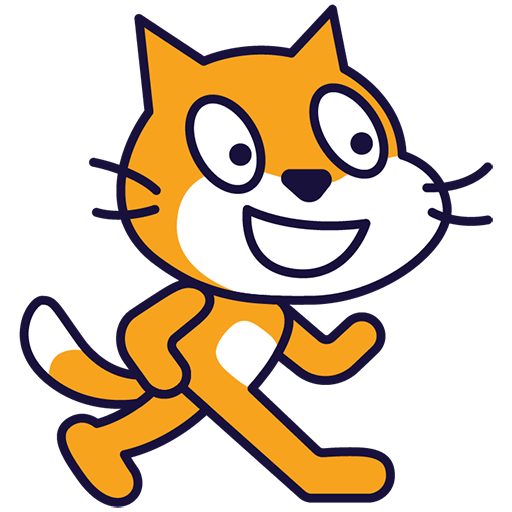
Coding and Interactive Creators
Code Like a Creator, Design Amazing Games and Animations with Scratch!
Student Devices
To do this module, students will need to use either of these devices:
 Chromebooks, laptops, and PCs are crucial tools for coding and digital skills education. Chromebooks are ideal for web-based applications and collaborative projects, while laptops and PCs support a wider range of programming environments and software for more intensive tasks like software development and data analysis.
Chromebooks, laptops, and PCs are crucial tools for coding and digital skills education. Chromebooks are ideal for web-based applications and collaborative projects, while laptops and PCs support a wider range of programming environments and software for more intensive tasks like software development and data analysis.Equipped with full keyboards and the ability to run specialized coding software, these devices enable students to learn programming languages, debug code, and understand software architecture. Their versatility supports both individual learning and group projects, making them indispensable for developing critical digital and computational thinking skills in the classroom.

iPads and tablets are versatile, portable computing devices that offer a wide range of educational applications in the classroom. Featuring touch-sensitive screens ranging from 7 to 13 inches, these devices allow students and teachers to interact directly with content through touch, swipe, and voice commands.
If necessary, students can work in groups (ideally in a group of 2 or 3 students) and use one device between them.
Module 3
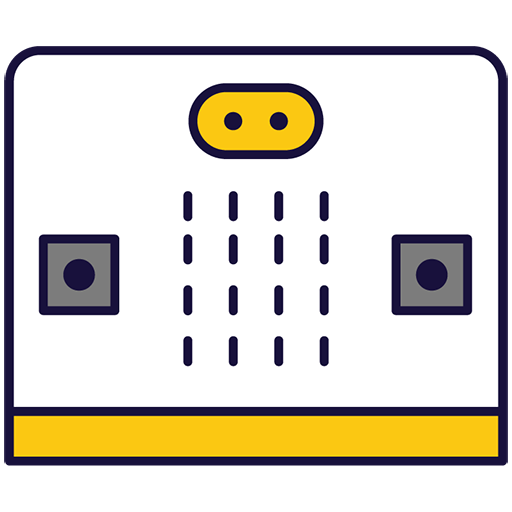
Microbit Masterclass
Developing skills through engaging microbit projects
Student Devices
To do this module, students will need to use either of these devices:
 Chromebooks, laptops, and PCs are crucial tools for coding and digital skills education. Chromebooks are ideal for web-based applications and collaborative projects, while laptops and PCs support a wider range of programming environments and software for more intensive tasks like software development and data analysis.
Chromebooks, laptops, and PCs are crucial tools for coding and digital skills education. Chromebooks are ideal for web-based applications and collaborative projects, while laptops and PCs support a wider range of programming environments and software for more intensive tasks like software development and data analysis.Equipped with full keyboards and the ability to run specialized coding software, these devices enable students to learn programming languages, debug code, and understand software architecture. Their versatility supports both individual learning and group projects, making them indispensable for developing critical digital and computational thinking skills in the classroom.
If necessary, students can work in groups (ideally in a group of 2 or 3 students) and use one device between them.
Lesson Equipment
Students will need to use the following equipment and can share if necessary.

The BBC microbit is a pocket-sized codeable computer with motion detection, a built-in compass and Bluetooth technology.
The board measures 4 cm × 5 cm and has a processor, accelerometer and magnetometer sensors, Bluetooth and USB connectivity, a display consisting of 25 LEDs, two programmable buttons, and can be powered by either USB or an external battery pack.
The list of things you can program the Microbit to do is nearly endless. You can program the buttons, LEDs and different sensors to create games and turn the Microbit into things like a pedometer, a compass or even a musical instrument.
Coding Ireland can provide full classroom kits, please provide student numbers to get a quote.
Module 2

Game Design Studio
Design Arcade Games with Advanced Logic
Student Devices
To do this module, students will need to use either of these devices:
 Chromebooks, laptops, and PCs are crucial tools for coding and digital skills education. Chromebooks are ideal for web-based applications and collaborative projects, while laptops and PCs support a wider range of programming environments and software for more intensive tasks like software development and data analysis.
Chromebooks, laptops, and PCs are crucial tools for coding and digital skills education. Chromebooks are ideal for web-based applications and collaborative projects, while laptops and PCs support a wider range of programming environments and software for more intensive tasks like software development and data analysis.Equipped with full keyboards and the ability to run specialized coding software, these devices enable students to learn programming languages, debug code, and understand software architecture. Their versatility supports both individual learning and group projects, making them indispensable for developing critical digital and computational thinking skills in the classroom.

iPads and tablets are versatile, portable computing devices that offer a wide range of educational applications in the classroom. Featuring touch-sensitive screens ranging from 7 to 13 inches, these devices allow students and teachers to interact directly with content through touch, swipe, and voice commands.
If necessary, students can work in groups (ideally in a group of 2 or 3 students) and use one device between them.
Module 4

Exploring Electronics and Light
Microbit Makers: Code Light Shows & Interactive Projects!
Student Devices
To do this module, students will need to use either of these devices:
 Chromebooks, laptops, and PCs are crucial tools for coding and digital skills education. Chromebooks are ideal for web-based applications and collaborative projects, while laptops and PCs support a wider range of programming environments and software for more intensive tasks like software development and data analysis.
Chromebooks, laptops, and PCs are crucial tools for coding and digital skills education. Chromebooks are ideal for web-based applications and collaborative projects, while laptops and PCs support a wider range of programming environments and software for more intensive tasks like software development and data analysis.Equipped with full keyboards and the ability to run specialized coding software, these devices enable students to learn programming languages, debug code, and understand software architecture. Their versatility supports both individual learning and group projects, making them indispensable for developing critical digital and computational thinking skills in the classroom.
If necessary, students can work in groups (ideally in a group of 2 or 3 students) and use one device between them.
Lesson Equipment
Students will need to use the following equipment and can share if necessary.
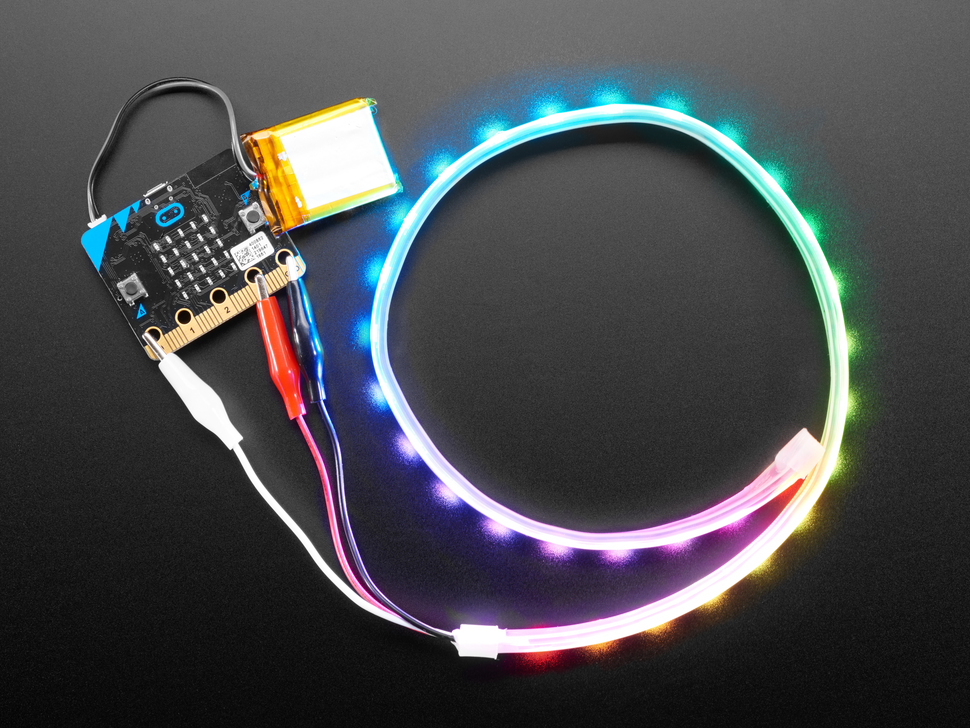
The Adafruit NeoPixel LED Strip is a flexible, programmable strip of individually addressable RGB LEDs. Each LED can be controlled separately to display a wide range of colors and patterns.
Ideal for creative and educational projects, these strips can be used to teach students about coding, electronics, and design. By using platforms like Microbits or Arduino, students can program the LED strip to create custom lighting effects, interactive displays, or even simple animations. Perfect for classroom activities, the NeoPixel LED Strip provides a vibrant and engaging way to explore technology and creativity.

The BBC microbit is a pocket-sized codeable computer with motion detection, a built-in compass and Bluetooth technology.
The board measures 4 cm × 5 cm and has a processor, accelerometer and magnetometer sensors, Bluetooth and USB connectivity, a display consisting of 25 LEDs, two programmable buttons, and can be powered by either USB or an external battery pack.
The list of things you can program the Microbit to do is nearly endless. You can program the buttons, LEDs and different sensors to create games and turn the Microbit into things like a pedometer, a compass or even a musical instrument.
Coding Ireland can provide full classroom kits, please provide student numbers to get a quote.
6th Class
Introduction Module

Introduction to Coding
Beginner's Gateway to Coding
Student Devices
To do this module, students will need to use either of these devices:
 Chromebooks, laptops, and PCs are crucial tools for coding and digital skills education. Chromebooks are ideal for web-based applications and collaborative projects, while laptops and PCs support a wider range of programming environments and software for more intensive tasks like software development and data analysis.
Chromebooks, laptops, and PCs are crucial tools for coding and digital skills education. Chromebooks are ideal for web-based applications and collaborative projects, while laptops and PCs support a wider range of programming environments and software for more intensive tasks like software development and data analysis.Equipped with full keyboards and the ability to run specialized coding software, these devices enable students to learn programming languages, debug code, and understand software architecture. Their versatility supports both individual learning and group projects, making them indispensable for developing critical digital and computational thinking skills in the classroom.

iPads and tablets are versatile, portable computing devices that offer a wide range of educational applications in the classroom. Featuring touch-sensitive screens ranging from 7 to 13 inches, these devices allow students and teachers to interact directly with content through touch, swipe, and voice commands.
If necessary, students can work in groups (ideally in a group of 2 or 3 students) and use one device between them.
Module 1
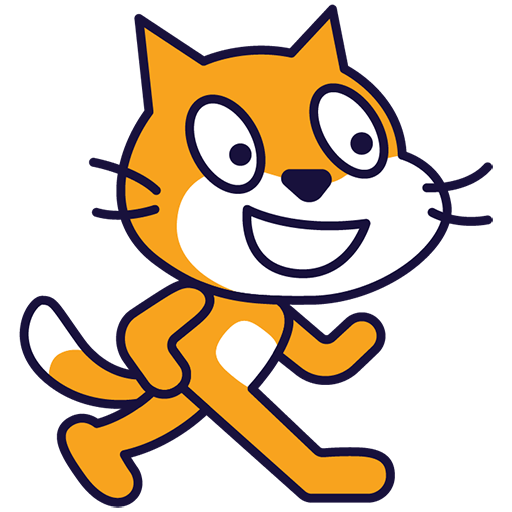
Digital Creation Lab
Build Interactive Projects with Code
Student Devices
To do this module, students will need to use either of these devices:
 Chromebooks, laptops, and PCs are crucial tools for coding and digital skills education. Chromebooks are ideal for web-based applications and collaborative projects, while laptops and PCs support a wider range of programming environments and software for more intensive tasks like software development and data analysis.
Chromebooks, laptops, and PCs are crucial tools for coding and digital skills education. Chromebooks are ideal for web-based applications and collaborative projects, while laptops and PCs support a wider range of programming environments and software for more intensive tasks like software development and data analysis.Equipped with full keyboards and the ability to run specialized coding software, these devices enable students to learn programming languages, debug code, and understand software architecture. Their versatility supports both individual learning and group projects, making them indispensable for developing critical digital and computational thinking skills in the classroom.

iPads and tablets are versatile, portable computing devices that offer a wide range of educational applications in the classroom. Featuring touch-sensitive screens ranging from 7 to 13 inches, these devices allow students and teachers to interact directly with content through touch, swipe, and voice commands.
If necessary, students can work in groups (ideally in a group of 2 or 3 students) and use one device between them.
Module 3
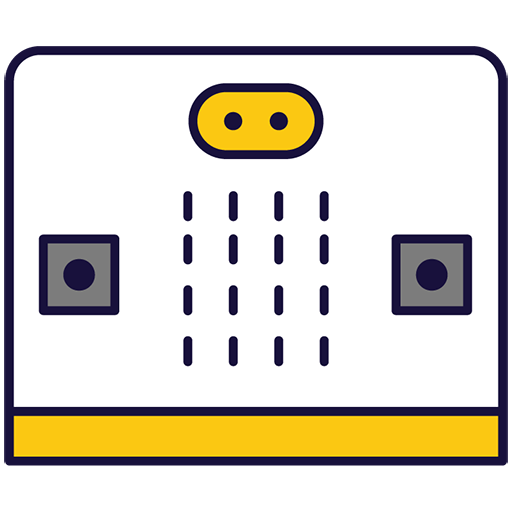
Microbit Innovators
Coding microbit projects and real-world applications
Student Devices
To do this module, students will need to use either of these devices:
 Chromebooks, laptops, and PCs are crucial tools for coding and digital skills education. Chromebooks are ideal for web-based applications and collaborative projects, while laptops and PCs support a wider range of programming environments and software for more intensive tasks like software development and data analysis.
Chromebooks, laptops, and PCs are crucial tools for coding and digital skills education. Chromebooks are ideal for web-based applications and collaborative projects, while laptops and PCs support a wider range of programming environments and software for more intensive tasks like software development and data analysis.Equipped with full keyboards and the ability to run specialized coding software, these devices enable students to learn programming languages, debug code, and understand software architecture. Their versatility supports both individual learning and group projects, making them indispensable for developing critical digital and computational thinking skills in the classroom.
If necessary, students can work in groups (ideally in a group of 2 or 3 students) and use one device between them.
Lesson Equipment
Students will need to use the following equipment and can share if necessary.

The BBC microbit is a pocket-sized codeable computer with motion detection, a built-in compass and Bluetooth technology.
The board measures 4 cm × 5 cm and has a processor, accelerometer and magnetometer sensors, Bluetooth and USB connectivity, a display consisting of 25 LEDs, two programmable buttons, and can be powered by either USB or an external battery pack.
The list of things you can program the Microbit to do is nearly endless. You can program the buttons, LEDs and different sensors to create games and turn the Microbit into things like a pedometer, a compass or even a musical instrument.
Coding Ireland can provide full classroom kits, please provide student numbers to get a quote.
Module 2
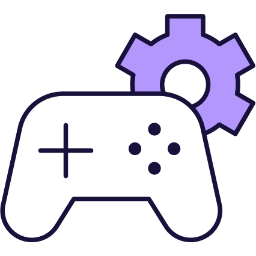
Advanced Game Development
Code Like a Pro, From Classics to Cutting-Edge Games!
Student Devices
To do this module, students will need to use either of these devices:
 Chromebooks, laptops, and PCs are crucial tools for coding and digital skills education. Chromebooks are ideal for web-based applications and collaborative projects, while laptops and PCs support a wider range of programming environments and software for more intensive tasks like software development and data analysis.
Chromebooks, laptops, and PCs are crucial tools for coding and digital skills education. Chromebooks are ideal for web-based applications and collaborative projects, while laptops and PCs support a wider range of programming environments and software for more intensive tasks like software development and data analysis.Equipped with full keyboards and the ability to run specialized coding software, these devices enable students to learn programming languages, debug code, and understand software architecture. Their versatility supports both individual learning and group projects, making them indispensable for developing critical digital and computational thinking skills in the classroom.

iPads and tablets are versatile, portable computing devices that offer a wide range of educational applications in the classroom. Featuring touch-sensitive screens ranging from 7 to 13 inches, these devices allow students and teachers to interact directly with content through touch, swipe, and voice commands.
If necessary, students can work in groups (ideally in a group of 2 or 3 students) and use one device between them.
Module 4

Exploring Electronics and Light
Microbit Makers: Code Light Shows & Interactive Projects!
Student Devices
To do this module, students will need to use either of these devices:
 Chromebooks, laptops, and PCs are crucial tools for coding and digital skills education. Chromebooks are ideal for web-based applications and collaborative projects, while laptops and PCs support a wider range of programming environments and software for more intensive tasks like software development and data analysis.
Chromebooks, laptops, and PCs are crucial tools for coding and digital skills education. Chromebooks are ideal for web-based applications and collaborative projects, while laptops and PCs support a wider range of programming environments and software for more intensive tasks like software development and data analysis.Equipped with full keyboards and the ability to run specialized coding software, these devices enable students to learn programming languages, debug code, and understand software architecture. Their versatility supports both individual learning and group projects, making them indispensable for developing critical digital and computational thinking skills in the classroom.
If necessary, students can work in groups (ideally in a group of 2 or 3 students) and use one device between them.
Lesson Equipment
Students will need to use the following equipment and can share if necessary.

The Adafruit NeoPixel LED Strip is a flexible, programmable strip of individually addressable RGB LEDs. Each LED can be controlled separately to display a wide range of colors and patterns.
Ideal for creative and educational projects, these strips can be used to teach students about coding, electronics, and design. By using platforms like Microbits or Arduino, students can program the LED strip to create custom lighting effects, interactive displays, or even simple animations. Perfect for classroom activities, the NeoPixel LED Strip provides a vibrant and engaging way to explore technology and creativity.

The BBC microbit is a pocket-sized codeable computer with motion detection, a built-in compass and Bluetooth technology.
The board measures 4 cm × 5 cm and has a processor, accelerometer and magnetometer sensors, Bluetooth and USB connectivity, a display consisting of 25 LEDs, two programmable buttons, and can be powered by either USB or an external battery pack.
The list of things you can program the Microbit to do is nearly endless. You can program the buttons, LEDs and different sensors to create games and turn the Microbit into things like a pedometer, a compass or even a musical instrument.
Coding Ireland can provide full classroom kits, please provide student numbers to get a quote.
Module 4

Designing and Building for the Future
Robotics Champions: Animate & Control Your Microbit Car!
Student Devices
To do this module, students will need to use either of these devices:
 Chromebooks, laptops, and PCs are crucial tools for coding and digital skills education. Chromebooks are ideal for web-based applications and collaborative projects, while laptops and PCs support a wider range of programming environments and software for more intensive tasks like software development and data analysis.
Chromebooks, laptops, and PCs are crucial tools for coding and digital skills education. Chromebooks are ideal for web-based applications and collaborative projects, while laptops and PCs support a wider range of programming environments and software for more intensive tasks like software development and data analysis.Equipped with full keyboards and the ability to run specialized coding software, these devices enable students to learn programming languages, debug code, and understand software architecture. Their versatility supports both individual learning and group projects, making them indispensable for developing critical digital and computational thinking skills in the classroom.

The BBC microbit is a pocket-sized codeable computer with motion detection, a built-in compass and Bluetooth technology.
The board measures 4 cm × 5 cm and has a processor, accelerometer and magnetometer sensors, Bluetooth and USB connectivity, a display consisting of 25 LEDs, two programmable buttons, and can be powered by either USB or an external battery pack.
The list of things you can program the Microbit to do is nearly endless. You can program the buttons, LEDs and different sensors to create games and turn the Microbit into things like a pedometer, a compass or even a musical instrument.
If necessary, students can work in groups (ideally in a group of 2 or 3 students) and use one device between them.
Lesson Equipment
Students will need to use the following equipment and can share if necessary.

The BBC microbit is a pocket-sized codeable computer with motion detection, a built-in compass and Bluetooth technology.
The board measures 4 cm × 5 cm and has a processor, accelerometer and magnetometer sensors, Bluetooth and USB connectivity, a display consisting of 25 LEDs, two programmable buttons, and can be powered by either USB or an external battery pack.
The list of things you can program the Microbit to do is nearly endless. You can program the buttons, LEDs and different sensors to create games and turn the Microbit into things like a pedometer, a compass or even a musical instrument.
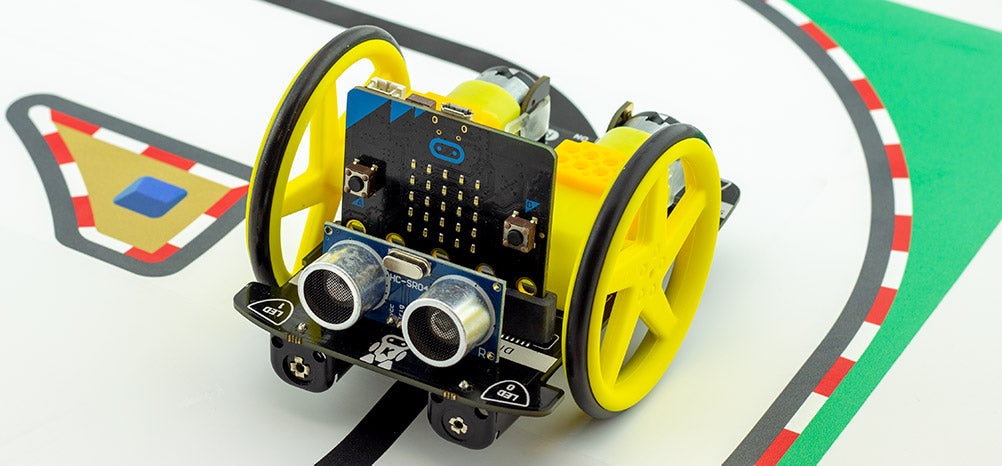
The Move Motor Car is a versatile, programmable vehicle that is powered and controlled by the micro:bit, a pocket-sized computer.
This car has motorized wheels and a variety of sensors, allowing students to create and test different robotics and coding projects. By connecting a micro:bit to the car, students can use the MakeCode platform to program the vehicle's movements, speed, and responses to sensor inputs. This provides an engaging and hands-on way for students to learn about coding, robotics, and engineering concepts.
Whether it's navigating through a maze, following a line on the ground, or responding to obstacles, the Move Motor Sensor Car offers endless opportunities for creativity and problem-solving. Perfect for classroom activities, it allows students to explore STEM concepts in an interactive and enjoyable way.
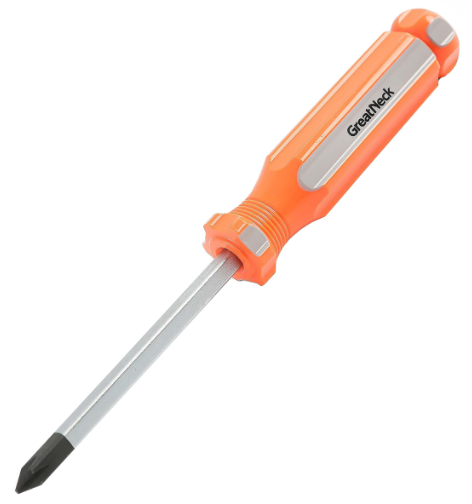
A Phillips screwdriver is a hand tool with a cross-shaped tip, designed to drive screws with a matching recessed cross or "Phillips" head. It's commonly used in a wide range of applications, including assembly and repair of appliances, electronics, and furniture. Essential for many classroom projects, it helps students learn practical skills and safely connect components.

The STOP:bit for the BBC micro:bit is the ultimate upgrade for traffic light/pedestrian crossing projects. It is a bolt-on/clip-on board for the BBC micro:bit replicating a traffic light.
Coding Ireland can provide full classroom kits, please provide student numbers to get a quote.
Module 6
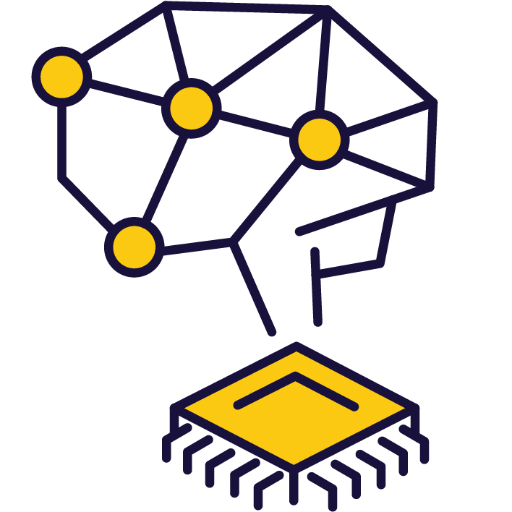
Discovering Artificial Intelligence
Discover AI and learn how to program it using Scratch.
Student Devices
To do this module, students will need to use either of these devices:
 Chromebooks, laptops, and PCs are crucial tools for coding and digital skills education. Chromebooks are ideal for web-based applications and collaborative projects, while laptops and PCs support a wider range of programming environments and software for more intensive tasks like software development and data analysis.
Chromebooks, laptops, and PCs are crucial tools for coding and digital skills education. Chromebooks are ideal for web-based applications and collaborative projects, while laptops and PCs support a wider range of programming environments and software for more intensive tasks like software development and data analysis.Equipped with full keyboards and the ability to run specialized coding software, these devices enable students to learn programming languages, debug code, and understand software architecture. Their versatility supports both individual learning and group projects, making them indispensable for developing critical digital and computational thinking skills in the classroom.

iPads and tablets are versatile, portable computing devices that offer a wide range of educational applications in the classroom. Featuring touch-sensitive screens ranging from 7 to 13 inches, these devices allow students and teachers to interact directly with content through touch, swipe, and voice commands.
If necessary, students can work in groups (ideally in a group of 2 or 3 students) and use one device between them.
Lesson Equipment
Students will need to use the following equipment and can share if necessary.
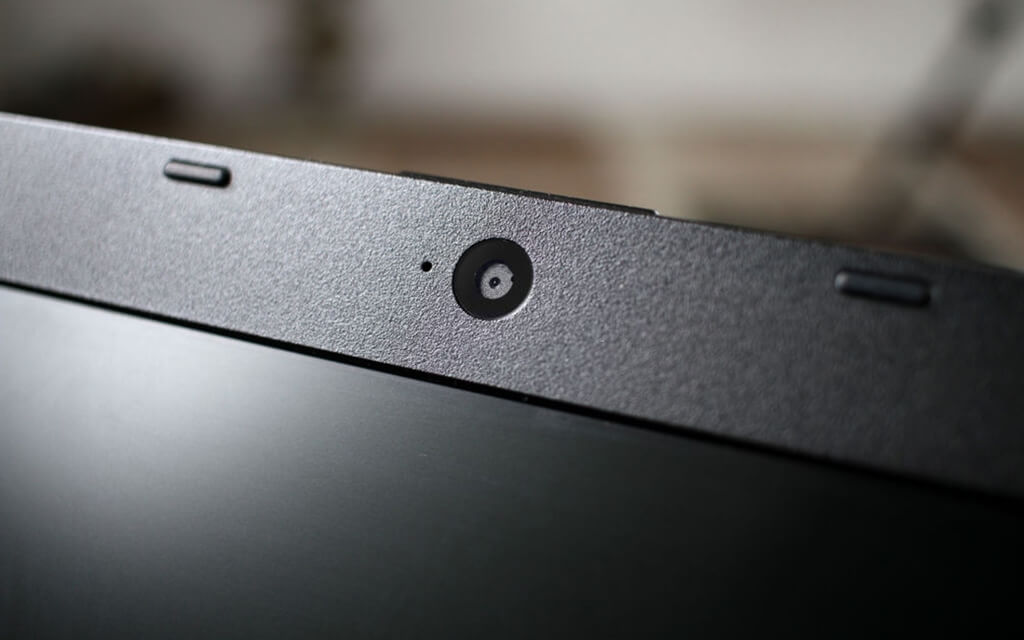
A webcam is a small digital camera, either standalone or built into a computer, used for taking videos and images.
Most modern iPads, tablets, laptops and Chromebooks have cameras built into them.
Coding Ireland can provide full classroom kits, please provide student numbers to get a quote.
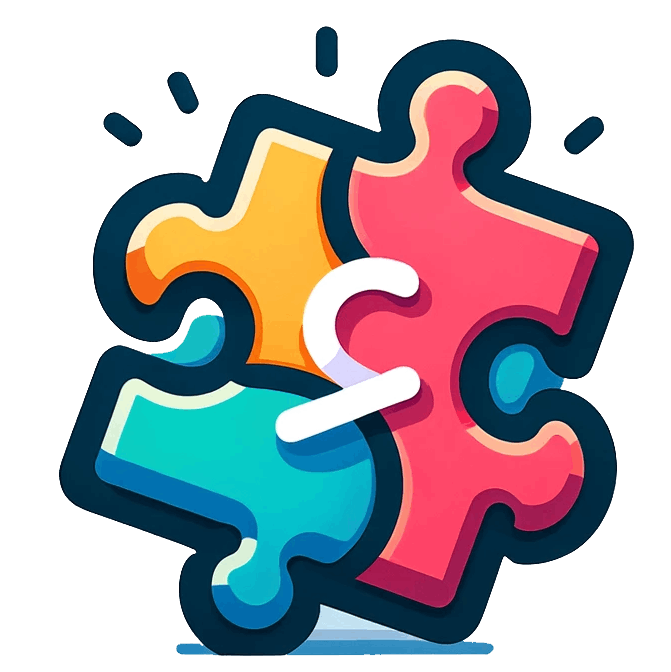 Exploring Patterns
Exploring Patterns
Get Started
Course Description
8 week course @ 1 hour per week
This module guides teachers through a series of lessons designed to introduce students to the concept of sequencing and logical order, essential for understanding coding instructions. The module includes interactive games, discussions, and worksheet activities, progressing from simple 'first/then' statements to more complex grid navigation tasks. Teachers are advised to explain concepts clearly, make learning fun and relatable, and encourage students to visualise movements and explain their thought processes.
- Understand and apply the concept of sequencing everyday activities using 'first/then' statements.
- Sequence actions using "if/then" statements to understand cause and effect relationships.
- Arrange steps of daily activities in the correct order to understand the logical flow of events.
- Learn and apply the concept of grid navigation through forward and backward movement.
- Navigate a character on a larger 4x4 grid, expanding from the previous understanding of a 3x3 grid.
The equipment listed below is used in several lessons throughout this course. Please note that these items can be shared among students if necessary.

A teacher interactive display is a device that allows teachers and students to interact with digital content on a large screen. It can be used for various purposes, such as presenting, annotating, collaborating, and engaging in interactive learning activities. Some examples of teacher interactive displays are SMART Board1, Clevertouch2, and Epson3. These displays have different features and specifications, such as touch sensitivity, embedded computing, software compatibility, and screen size. Teacher interactive displays can enhance the teaching and learning experience by making it more dynamic, collaborative, and fun.
Week 1
Week 2
Week 3
Week 4
Week 5
Week 6
.png) My First Steps in Digital Storytelling
My First Steps in Digital Storytelling
Get Started
Course Description
8 week course @ 1 hour per week
This module introduces students to the basics of digital storytelling using Scratch Jr. The lessons are designed to be interactive and hands-on, encouraging students to explore and experiment with the app. Teachers should monitor student progress and provide assistance as needed. The module covers topics such as character movement, changing backgrounds, adding characters, and programming actions. Each lesson concludes with a challenge and free play exploration time, allowing students to apply what they've learned.
- Utilise Scratch Jr. app to create interactive stories and games.
- Manipulate Scratch the Cat character and use basic motion blocks for movement.
- Change backgrounds and create unique dance routines for characters in Scratch Junior.
- Add multiple characters and program them to perform simultaneous actions.
- Control character speed, sequence commands, and create a racing game with different sprites.
- Program a spaceman character to perform continuous floating motions in a space-themed environment.
The equipment listed below is used in several lessons throughout this course. Please note that these items can be shared among students if necessary.

iPads and tablets are versatile, portable computing devices that offer a wide range of educational applications in the classroom. Featuring touch-sensitive screens ranging from 7 to 13 inches, these devices allow students and teachers to interact directly with content through touch, swipe, and voice commands.
Week 2
Week 3
Week 4
Week 5
Week 6
 Journey into Robotic Movements
Journey into Robotic Movements
Get Started
Course Description
8 week course @ 1 hour per week
Introduce your students to the exciting world of robotics with Bee-Bots. Start with simple forward and backward movements, then progress to lateral turns. Engage students with interactive games and hands-on activities, reinforcing their understanding of directional commands and sequencing. As The module progresses, students will learn to programme Bee-Bots to trace digital numbers, enhancing their number recognition, sequencing skills, and programming abilities. Remember to celebrate their achievements and encourage further exploration.
- Control Bee-Bot's forward and backward movements through programmable commands.
- Execute Bee-Bot's left and right turns, demonstrating understanding of lateral movements.
- Apply directional commands and sequencing to guide Bee-Bots in planting flowers on a grid mat.
- Programme Bee-Bot to locate a specific object, demonstrating enhanced coding skills.
- Programme Bee-Bot to trace digital numbers, demonstrating improved number recognition, sequencing skills, and programming abilities.
The equipment listed below is used in several lessons throughout this course. Please note that these items can be shared among students if necessary.

The Bee-Bot is a child-friendly, programmable robot designed to introduce young students to basic programming concepts, including sequencing and problem-solving. This bee-shaped robot measures approximately 13 cm by 10 cm, featuring a simple interface with directional buttons to input commands for movement.
Capable of remembering up to 40 commands, Bee-Bot can move in 15 cm steps and turn 90 degrees, ideal for executing planned sequences. Its durable, colourful design and rechargeable battery via USB make it both classroom-friendly and easy to maintain. Teachers can use Bee-Bots with various thematic mats and accessories to enhance learning across different subjects, promoting creativity and teamwork among students.
Week 1
Week 2
Week 3
Week 4
Week 5
Week 6
 Solving Problems
Solving Problems
Get Started
Course Description
8 week course @ 1 hour per week
This module focuses on problem-solving skills, primarily through sequencing and conditional logic. Engage students with interactive games like 'Simon Says' and 'Robot Roger', and reinforce learning with worksheets. Use the whiteboard for visual demonstrations and remember to vary themes to maintain interest. Encourage students to learn at their own pace and ensure they understand each concept before moving on.
- Apply 'first/then' statements and 'Bossy Words' to understand sequencing in coding.
- Utilise 'if/then' statements to comprehend conditional logic through interactive activities.
- Demonstrate understanding of event sequencing through games and worksheet activities.
- Follow and give instructions for navigation using colours and numbers in games and worksheet activities.
- Navigate a character on a 4x4 grid using up and down arrows, focusing on numbers, fruits, and colours.
- Enhance problem-solving skills and spatial awareness by navigating a character on a 5x5 grid with various themes.
The equipment listed below is used in several lessons throughout this course. Please note that these items can be shared among students if necessary.

A teacher interactive display is a device that allows teachers and students to interact with digital content on a large screen. It can be used for various purposes, such as presenting, annotating, collaborating, and engaging in interactive learning activities. Some examples of teacher interactive displays are SMART Board1, Clevertouch2, and Epson3. These displays have different features and specifications, such as touch sensitivity, embedded computing, software compatibility, and screen size. Teacher interactive displays can enhance the teaching and learning experience by making it more dynamic, collaborative, and fun.
Week 1
Week 2
Week 3
Week 4
Week 5
Week 6
.png) Creative Stories
Creative Stories
Get Started
Course Description
8 week course @ 1 hour per week
This module introduces students to the basics of coding through Scratch Junior, using engaging themes and characters. Each week, students will learn new skills, from basic motion blocks to advanced coding tricks. Encourage creativity and exploration during free play time. For early finishers, provide additional challenges to keep them engaged. Remember to recap previous lessons to reinforce learning.
- Master the use of basic motion blocks to move characters in Scratch Junior.
- Create unique dance routines and change backgrounds in Scratch Junior.
- Add a second character and make characters walk together in Scratch Junior.
- Programme a car to drive across a city background and resize it in Scratch Junior.
- Control character speed, sequence commands, and create an animal race in Scratch Junior.
- Programme a spaceman to float in space, repeat actions, and create a 'space dance' in Scratch Junior.
The equipment listed below is used in several lessons throughout this course. Please note that these items can be shared among students if necessary.

iPads and tablets are versatile, portable computing devices that offer a wide range of educational applications in the classroom. Featuring touch-sensitive screens ranging from 7 to 13 inches, these devices allow students and teachers to interact directly with content through touch, swipe, and voice commands.
Week 1
Week 2
Week 3
Week 4
Week 5
Week 6
 Exploring Robotics and Commands
Exploring Robotics and Commands
Get Started
Course Description
8 week course @ 1 hour per week
This module involves guiding students through the exploration of robotics using Bee-Bots. The lessons are designed to progressively build students' understanding of commands and sequencing. Encourage hands-on participation and group activities to foster problem-solving and collaborative skills. Remember to recap previous lessons to reinforce learning. The module concludes with students applying their skills to trace digital numbers, reinforcing number recognition and programming.
- Master the operation of Bee-Bot, including forward and backward movements.
- Understand and execute lateral movements with Bee-Bot, including turns and changes in direction.
- Apply directional commands and sequencing to perform tasks such as planting flowers using Bee-Bot.
- Enhance programming skills and understanding of sequencing through activities like guiding Bee-Bot to a specific location.
- Develop spatial awareness and problem-solving skills by programming Bee-Bot to draw shapes and trace numbers.
The equipment listed below is used in several lessons throughout this course. Please note that these items can be shared among students if necessary.

The Bee-Bot is a child-friendly, programmable robot designed to introduce young students to basic programming concepts, including sequencing and problem-solving. This bee-shaped robot measures approximately 13 cm by 10 cm, featuring a simple interface with directional buttons to input commands for movement.
Capable of remembering up to 40 commands, Bee-Bot can move in 15 cm steps and turn 90 degrees, ideal for executing planned sequences. Its durable, colourful design and rechargeable battery via USB make it both classroom-friendly and easy to maintain. Teachers can use Bee-Bots with various thematic mats and accessories to enhance learning across different subjects, promoting creativity and teamwork among students.
Week 1
Week 2
Week 3
Week 4
Week 5
Week 6
 The World of Logic
The World of Logic
Get Started
Course Description
8 week course @ 1 hour per week
The World of Logic module is designed to introduce students to essential logical thinking skills through engaging and interactive activities. Starting with fundamental pattern recognition, students will advance to understanding categorization and identifying outliers. Teachers will guide students through sequencing tasks, reinforcing the importance of order and direction with fun grid games and maze challenges. The module concludes with an introduction to algorithms, where students apply their learning by creating simple dance routines. This module aims to build foundational critical thinking skills, essential for problem-solving in computer science and coding.
- Identify and complete patterns using games and worksheets.
- Understand and apply the concept of categorisation and outlier identification through interactive tasks.
- Demonstrate understanding of sequencing and following instructions through games and worksheets.
- Apply logical thinking and problem-solving skills in navigating and mapping grids.
- Create and understand algorithms through the creation of dance routines.
The equipment listed below is used in several lessons throughout this course. Please note that these items can be shared among students if necessary.

A teacher interactive display is a device that allows teachers and students to interact with digital content on a large screen. It can be used for various purposes, such as presenting, annotating, collaborating, and engaging in interactive learning activities. Some examples of teacher interactive displays are SMART Board1, Clevertouch2, and Epson3. These displays have different features and specifications, such as touch sensitivity, embedded computing, software compatibility, and screen size. Teacher interactive displays can enhance the teaching and learning experience by making it more dynamic, collaborative, and fun.
Week 1
Week 2
Week 3
Week 4
Week 5
Week 6
 Adventures in Digital Creation
Adventures in Digital Creation
Get Started
Course Description
8 week course @ 1 hour per week
This module introduces students to the world of digital creation through Scratch Junior. Starting with basic motion blocks, students will progressively learn to create projects, change backgrounds, add characters, and control character speed. Each lesson concludes with a challenge and free play exploration time. Teachers should encourage creativity and experimentation, and be prepared to recap on previous lessons as necessary.
- Manipulate basic motion blocks to move characters in Scratch Junior.
- Create and modify backgrounds, and choreograph a dance routine for characters in Scratch Junior.
- Add a second character in Scratch Junior and coordinate their movements.
- Programme a car to drive across a city background and adjust its size in Scratch Junior.
- Control character speed, sequence commands, and create a race with different sprites in Scratch Junior.
- Programme a spaceman character to float in space using repeat actions in Scratch Junior.
The equipment listed below is used in several lessons throughout this course. Please note that these items can be shared among students if necessary.

iPads and tablets are versatile, portable computing devices that offer a wide range of educational applications in the classroom. Featuring touch-sensitive screens ranging from 7 to 13 inches, these devices allow students and teachers to interact directly with content through touch, swipe, and voice commands.
Week 1
Week 2
Week 3
Week 4
Week 5
Week 6
Week 7
 Electricity and Simple Circuits
Electricity and Simple Circuits
Get Started
Course Description
8 week course @ 1 hour per week
This module involves guiding students through the understanding and application of electricity and simple circuits using Snap Circuits. Teachers will facilitate hands-on activities, including assembling circuits and experimenting with various components such as switches, LED lights, motors, and phototransistors. Emphasise safety, correct component placement, and the function of each part. Encourage exploration and reinforce learning through play. Familiarise yourself with Snap Circuits and prepare for each lesson by ensuring all necessary components are available.
- Assemble and operate a simple circuit using a switch block and lamp block.
- Construct and control an electric light circuit using a press switch.
- Build and activate a motor fan circuit using a press switch.
- Create a basic LED circuit, understanding the importance of electricity flow direction.
- Construct a light-responsive circuit using a phototransistor and LED light block.
- Assemble a circuit and identify electrical conductors and insulators through experimentation.
The equipment listed below is used in several lessons throughout this course. Please note that these items can be shared among students if necessary.

Snap Circuits are hands-on learning kits designed to teach students about electronics and circuit design in an intuitive and interactive way. These kits consist of various electronic components like resistors, switches, motors, and speakers that snap together on a plastic grid—no soldering required.
Each kit comes with easy-to-follow instructions that guide students through the construction of working circuits to create projects like radios, alarms, and doorbells. This practical approach helps students understand the basics of electrical circuits and the functionality of different components by seeing and modifying the circuits they build.
Snap Circuits are durable, reusable, and expandable, making them an ideal resource for classroom settings. They foster critical thinking, problem-solving, and creativity, providing a foundational understanding of electrical engineering concepts through engaging, real-world applications.
Week 1
Week 2
Week 3
Week 4
Week 5
Week 6
 My First Coding Adventure
My First Coding Adventure
Get Started
Course Description
2 week course @ 1 hour per week
This module is designed to introduce students to the world of coding. The first week focuses on the basics of coding, using everyday examples and an instructional game to reinforce the concept. The second lesson introduces Scratch, a coding platform, and guides students through creating their first project. The second week builds on this knowledge, teaching students how to create a dance party animation with a cat and a bat. Teachers should encourage active participation, creativity, and practice throughout The module.
- Understand and explain the concept of coding as giving step-by-step instructions to a computer.
- Identify and discuss three everyday devices that use coding.
- Navigate and utilise Scratch to create a basic project, including making a sprite move, adding a loop, changing the numbers, and adding a backdrop.
- Create a dance party animation with a cat and a bat using Scratch, demonstrating the ability to add characters, control their movements, and add a backdrop.
- Understand and apply the concept of each sprite having its own code and the importance of practice in mastering coding.
To do this module, students will need to use one of these devices. If necessary, students can work in groups (ideally in a group of 2 or 3 students) and use one device between them.
 Chromebooks, laptops, and PCs are crucial tools for coding and digital skills education. Chromebooks are ideal for web-based applications and collaborative projects, while laptops and PCs support a wider range of programming environments and software for more intensive tasks like software development and data analysis.
Chromebooks, laptops, and PCs are crucial tools for coding and digital skills education. Chromebooks are ideal for web-based applications and collaborative projects, while laptops and PCs support a wider range of programming environments and software for more intensive tasks like software development and data analysis.Equipped with full keyboards and the ability to run specialized coding software, these devices enable students to learn programming languages, debug code, and understand software architecture. Their versatility supports both individual learning and group projects, making them indispensable for developing critical digital and computational thinking skills in the classroom.

iPads and tablets are versatile, portable computing devices that offer a wide range of educational applications in the classroom. Featuring touch-sensitive screens ranging from 7 to 13 inches, these devices allow students and teachers to interact directly with content through touch, swipe, and voice commands.
 Exploring Coding
Exploring Coding
Get Started
Course Description
8 week course @ 1 hour per week
This module introduces students to coding through Scratch, a block-based visual programming language. The module is divided into eight modules, each focusing on a different aspect of Scratch. The lessons range from creating interactive projects with sound effects to designing games and stories. Teachers should ensure students understand each step before proceeding, encourage creativity and experimentation, and facilitate group brainstorming sessions to foster teamwork. The module concludes with students creating their own Scratch projects, reinforcing the skills they've learned throughout The module.
- Develop a Scratch project with animal sprites that produce unique sounds when clicked.
- Create a game in Scratch where a sprite follows the mouse cursor.
- Design a rainbow paintbrush in Scratch using pen blocks, colour changing, and mouse movement features.
- Build a game in Scratch where a shark sprite catches fish sprites, using keyboard controls and sprite collision detection.
- Construct an interactive 'Balloon Pop' game in Scratch, utilising sprite clones, random positioning, and click-triggered sound effects.
- Create a simple story in Scratch, incorporating backdrop changes, character dialogue, and teleportation.
- Develop a simple game in Scratch, manipulating characters, controlling movement with keyboard keys, and enabling character interaction.
- Brainstorm, receive feedback, and initiate a group project in Scratch, fostering creativity and teamwork.
To do this module, students will need to use one of these devices. If necessary, students can work in groups (ideally in a group of 2 or 3 students) and use one device between them.
 Chromebooks, laptops, and PCs are crucial tools for coding and digital skills education. Chromebooks are ideal for web-based applications and collaborative projects, while laptops and PCs support a wider range of programming environments and software for more intensive tasks like software development and data analysis.
Chromebooks, laptops, and PCs are crucial tools for coding and digital skills education. Chromebooks are ideal for web-based applications and collaborative projects, while laptops and PCs support a wider range of programming environments and software for more intensive tasks like software development and data analysis.Equipped with full keyboards and the ability to run specialized coding software, these devices enable students to learn programming languages, debug code, and understand software architecture. Their versatility supports both individual learning and group projects, making them indispensable for developing critical digital and computational thinking skills in the classroom.

iPads and tablets are versatile, portable computing devices that offer a wide range of educational applications in the classroom. Featuring touch-sensitive screens ranging from 7 to 13 inches, these devices allow students and teachers to interact directly with content through touch, swipe, and voice commands.
Week 1
Week 2
Week 3
Week 4
Week 5
Week 6
Week 7
Week 8
 Creative Coding Challenges
Creative Coding Challenges
Get Started
Course Description
8 week course @ 1 hour per week
This module provides a comprehensive guide to creative coding, focusing on animation and character interaction. Teachers should encourage students to experiment with different characters and backgrounds, and to test their animations regularly. The module gradually builds up complexity, culminating in a final project where students create their own animated story. Teachers should emphasise the importance of planning and refining their projects for the best results.
- Animate characters by changing costumes and controlling their dance speed.
- Code character movements, including walking and bouncing, and implement loops for repeated actions.
- Create dynamic dialogues between characters, controlling timing for smooth conversation flow.
- Design and animate a conversation between characters, including speech recording and mouth animation.
- Animate moving backgrounds and create smooth scene transitions.
- Develop a hide-and-seek game with characters that appear and disappear.
- Master the use of broadcasts to trigger events and interactions in an animated story.
- Create an original animated story, applying learned skills for character animation, dialogue, scene control, and transitions.
The equipment listed below is used in several lessons throughout this course. Please note that these items can be shared among students if necessary.
 Chromebooks, laptops, and PCs are crucial tools for coding and digital skills education. Chromebooks are ideal for web-based applications and collaborative projects, while laptops and PCs support a wider range of programming environments and software for more intensive tasks like software development and data analysis.
Chromebooks, laptops, and PCs are crucial tools for coding and digital skills education. Chromebooks are ideal for web-based applications and collaborative projects, while laptops and PCs support a wider range of programming environments and software for more intensive tasks like software development and data analysis.Equipped with full keyboards and the ability to run specialized coding software, these devices enable students to learn programming languages, debug code, and understand software architecture. Their versatility supports both individual learning and group projects, making them indispensable for developing critical digital and computational thinking skills in the classroom.

iPads and tablets are versatile, portable computing devices that offer a wide range of educational applications in the classroom. Featuring touch-sensitive screens ranging from 7 to 13 inches, these devices allow students and teachers to interact directly with content through touch, swipe, and voice commands.
Week 1
Week 2
Week 3
Week 4
Week 5
Week 6
Week 7
Week 8
 Discovering the Magic of Circuits
Discovering the Magic of Circuits
Get Started
Course Description
8 week course @ 1 hour per week
This module involves guiding students through the fascinating world of circuits using Snap Circuits. Each week, you'll introduce new concepts, from understanding electricity and switches to exploring motors, LED lights, and phototransistors. The hands-on nature of The module requires you to ensure students understand the function and placement of each component. Encourage exploration and experimentation after each lesson to reinforce learning. Safety is paramount, so ensure all components are handled correctly.
- Understand and demonstrate the function of a switch in an electrical circuit using Snap Circuits.
- Construct and operate an electric light circuit controlled by a press switch.
- Assemble a circuit with a motor fan and press switch, demonstrating the operation of a motor in a circuit.
- Build a basic LED circuit, understanding the importance of the direction of electricity flow.
- Construct a light-responsive circuit using a phototransistor and LED light block, demonstrating the role of light in controlling electricity.
- Identify and classify objects as conductors or insulators through experimentation with a self-assembled circuit.
The equipment listed below is used in several lessons throughout this course. Please note that these items can be shared among students if necessary.

Snap Circuits are hands-on learning kits designed to teach students about electronics and circuit design in an intuitive and interactive way. These kits consist of various electronic components like resistors, switches, motors, and speakers that snap together on a plastic grid—no soldering required.
Each kit comes with easy-to-follow instructions that guide students through the construction of working circuits to create projects like radios, alarms, and doorbells. This practical approach helps students understand the basics of electrical circuits and the functionality of different components by seeing and modifying the circuits they build.
Snap Circuits are durable, reusable, and expandable, making them an ideal resource for classroom settings. They foster critical thinking, problem-solving, and creativity, providing a foundational understanding of electrical engineering concepts through engaging, real-world applications.
Week 1
Week 2
Week 3
Week 4
Week 5
Week 6
 My First Coding Adventure
My First Coding Adventure
Get Started
Course Description
2 week course @ 1 hour per week
This module is designed to introduce students to the world of coding. The first week focuses on the basics of coding, using everyday examples and an instructional game to reinforce the concept. The second lesson introduces Scratch, a coding platform, and guides students through creating their first project. The second week builds on this knowledge, teaching students how to create a dance party animation with a cat and a bat. Teachers should encourage active participation, creativity, and practice throughout The module.
- Understand and explain the concept of coding as giving step-by-step instructions to a computer.
- Identify and discuss three everyday devices that use coding.
- Navigate and utilise Scratch to create a basic project, including making a sprite move, adding a loop, changing the numbers, and adding a backdrop.
- Create a dance party animation with a cat and a bat using Scratch, demonstrating the ability to add characters, control their movements, and add a backdrop.
- Understand and apply the concept of each sprite having its own code and the importance of practice in mastering coding.
To do this module, students will need to use one of these devices. If necessary, students can work in groups (ideally in a group of 2 or 3 students) and use one device between them.
 Chromebooks, laptops, and PCs are crucial tools for coding and digital skills education. Chromebooks are ideal for web-based applications and collaborative projects, while laptops and PCs support a wider range of programming environments and software for more intensive tasks like software development and data analysis.
Chromebooks, laptops, and PCs are crucial tools for coding and digital skills education. Chromebooks are ideal for web-based applications and collaborative projects, while laptops and PCs support a wider range of programming environments and software for more intensive tasks like software development and data analysis.Equipped with full keyboards and the ability to run specialized coding software, these devices enable students to learn programming languages, debug code, and understand software architecture. Their versatility supports both individual learning and group projects, making them indispensable for developing critical digital and computational thinking skills in the classroom.

iPads and tablets are versatile, portable computing devices that offer a wide range of educational applications in the classroom. Featuring touch-sensitive screens ranging from 7 to 13 inches, these devices allow students and teachers to interact directly with content through touch, swipe, and voice commands.
 Coding and Creative Projects
Coding and Creative Projects
Get Started
Course Description
8 week course @ 1 hour per week
This module guides students through the basics of coding using Scratch, with a focus on creativity and project-based learning. Each week, students will create a new project, learning key coding concepts and Scratch tools along the way. Teachers should ensure students understand each step before progressing, encourage creativity and experimentation, and provide assistance as needed. The module concludes with a group project, fostering teamwork and idea generation.
- Develop a traffic light sequence in Scratch, demonstrating understanding of sequencing and sprite manipulation.
- Create a simple interactive game in Scratch, incorporating elements of random positioning, scoring, and visual effects.
- Utilise Scratch tools to create and modify a digital character, demonstrating proficiency in colour manipulation, reshaping, and adding shapes.
- Construct a banana stamp in Scratch, demonstrating control of the stamp with the mouse, and ability to change its colour, appearance, and clear the canvas.
- Create a virtual pet in Scratch, demonstrating skills in sprite manipulation, size and colour alteration, and coding for movement and sound.
- Develop an interactive fish tank in Scratch, demonstrating understanding of mouse-following sprites, clone creation, and randomised clone attributes.
- Create GIF animations in Scratch, demonstrating proficiency in GIF uploading, animation coding, and exploration of effects and sound.
- Brainstorm and initiate a simple Scratch project in a group setting, demonstrating creativity, teamwork, and application of Scratch skills learnt.
To do this module, students will need to use one of these devices. If necessary, students can work in groups (ideally in a group of 2 or 3 students) and use one device between them.
 Chromebooks, laptops, and PCs are crucial tools for coding and digital skills education. Chromebooks are ideal for web-based applications and collaborative projects, while laptops and PCs support a wider range of programming environments and software for more intensive tasks like software development and data analysis.
Chromebooks, laptops, and PCs are crucial tools for coding and digital skills education. Chromebooks are ideal for web-based applications and collaborative projects, while laptops and PCs support a wider range of programming environments and software for more intensive tasks like software development and data analysis.Equipped with full keyboards and the ability to run specialized coding software, these devices enable students to learn programming languages, debug code, and understand software architecture. Their versatility supports both individual learning and group projects, making them indispensable for developing critical digital and computational thinking skills in the classroom.

iPads and tablets are versatile, portable computing devices that offer a wide range of educational applications in the classroom. Featuring touch-sensitive screens ranging from 7 to 13 inches, these devices allow students and teachers to interact directly with content through touch, swipe, and voice commands.
Week 1
Week 2
Week 3
Week 4
Week 5
Week 6
Week 7
Week 8
 Introduction to Game Design
Introduction to Game Design
Get Started
Course Description
8 week course @ 1 hour per week
This module introduces students to game design using MakeCode Arcade. Teachers should familiarise themselves with the platform and guide students through creating various games, including 'Avoid the Enemy', 'Cherry Collection', and 'Beat The Clock'. Encourage creativity and exploration, and ensure students understand key concepts like sprite creation, game loops, and collision detection. The module culminates in a group project where students brainstorm and create their own games.
- Utilise MakeCode Arcade to design and control a sprite, and add effects.
- Create an 'Avoid the Enemy' game using MakeCode Arcade, including sprite interaction and dynamic gameplay.
- Develop a 'Cherry Collection' game with character movement, random food sprite generation, and sound effects.
- Design a 'Beat The Clock' game with a timer, scoring system, and sprite movement and interaction.
- Create a maze game with character control, maze design, camera control, and game-winning conditions.
To do this module, students will need to use one of these devices. If necessary, students can work in groups (ideally in a group of 2 or 3 students) and use one device between them.
 Chromebooks, laptops, and PCs are crucial tools for coding and digital skills education. Chromebooks are ideal for web-based applications and collaborative projects, while laptops and PCs support a wider range of programming environments and software for more intensive tasks like software development and data analysis.
Chromebooks, laptops, and PCs are crucial tools for coding and digital skills education. Chromebooks are ideal for web-based applications and collaborative projects, while laptops and PCs support a wider range of programming environments and software for more intensive tasks like software development and data analysis.Equipped with full keyboards and the ability to run specialized coding software, these devices enable students to learn programming languages, debug code, and understand software architecture. Their versatility supports both individual learning and group projects, making them indispensable for developing critical digital and computational thinking skills in the classroom.

iPads and tablets are versatile, portable computing devices that offer a wide range of educational applications in the classroom. Featuring touch-sensitive screens ranging from 7 to 13 inches, these devices allow students and teachers to interact directly with content through touch, swipe, and voice commands.
Week 1
Week 2
Week 3
Week 4
Week 5
Week 6
Week 7
Week 8
 Microbit Basics
Microbit Basics
Get Started
Course Description
8 week course @ 1 hour per week
Introduce your students to the world of microbits, pocket-sized programmable computers. Guide them through creating a new project, navigating the project editor, and writing their first piece of code. Encourage hands-on learning as they experiment with displaying messages, reacting to button presses, and showing a happy face. In subsequent lessons, they will create emojis, program a dice, measure temperature, learn about compass sensors, create animations, make music, and finally, brainstorm and execute their own microbit project.
- Program a microbit to display messages, react to button presses and show different faces.
- Develop a microbit program to function as a dice, displaying numbers between 1 and 6.
- Utilise a microbit to measure temperature and create a temperature-responsive narrative.
- Calibrate and program a microbit compass sensor to read and display directional data.
- Create a simple animation on a microbit device using 'show leds' blocks.
- Program a microbit to play a melody using the 'music.play' function in MakeCode.
- Brainstorm, develop and present a simple microbit project in a team.
To do this module, students will need to use one of these devices. If necessary, students can work in groups (ideally in a group of 2 or 3 students) and use one device between them.
 Chromebooks, laptops, and PCs are crucial tools for coding and digital skills education. Chromebooks are ideal for web-based applications and collaborative projects, while laptops and PCs support a wider range of programming environments and software for more intensive tasks like software development and data analysis.
Chromebooks, laptops, and PCs are crucial tools for coding and digital skills education. Chromebooks are ideal for web-based applications and collaborative projects, while laptops and PCs support a wider range of programming environments and software for more intensive tasks like software development and data analysis.Equipped with full keyboards and the ability to run specialized coding software, these devices enable students to learn programming languages, debug code, and understand software architecture. Their versatility supports both individual learning and group projects, making them indispensable for developing critical digital and computational thinking skills in the classroom.
The equipment listed below is used in several lessons throughout this course. Please note that these items can be shared among students if necessary.

The BBC microbit is a pocket-sized codeable computer with motion detection, a built-in compass and Bluetooth technology.
The board measures 4 cm × 5 cm and has a processor, accelerometer and magnetometer sensors, Bluetooth and USB connectivity, a display consisting of 25 LEDs, two programmable buttons, and can be powered by either USB or an external battery pack.
The list of things you can program the Microbit to do is nearly endless. You can program the buttons, LEDs and different sensors to create games and turn the Microbit into things like a pedometer, a compass or even a musical instrument.
Where to buy
Microbits can be purchased from a number of online retailers and can be purchased with and without a USB cable and battery pack. They can also be purchased in bulk from some retailers.
Online retailers
Week 1
Week 2
Week 3
Week 4
Week 5
Week 6
Week 7
Week 8
 Introduction to Coding
Introduction to Coding
Get Started
Course Description
2 week course @ 1 hour per week
This module introduces students to the fundamentals of coding, starting with an overview of what coding is and its applications. Teachers should utilise visual aids and interactive discussions. The module progresses to hands-on experience with Scratch, a coding platform for creating games and animations. Teachers should familiarise themselves with Scratch and be prepared to assist students. The module culminates in students creating a Paddle Ball Game, reinforcing their understanding of moving sprites, changing backdrops, and using sensing blocks. Teachers should ensure students understand X and Y coordinates and Scratch coding blocks.
- Understand the concept of coding and its applications.
- Develop basic skills in Scratch, including creating projects, adding sprites and backdrops, and making sprites move.
- Experiment with different code blocks in Scratch and learn from mistakes.
- Create a Paddle Ball Game using Scratch, demonstrating the ability to move sprites, change backdrops, and use sensing blocks.
- Understand and apply the concepts of X and Y coordinates in the context of Scratch coding.
To do this module, students will need to use one of these devices. If necessary, students can work in groups (ideally in a group of 2 or 3 students) and use one device between them.
 Chromebooks, laptops, and PCs are crucial tools for coding and digital skills education. Chromebooks are ideal for web-based applications and collaborative projects, while laptops and PCs support a wider range of programming environments and software for more intensive tasks like software development and data analysis.
Chromebooks, laptops, and PCs are crucial tools for coding and digital skills education. Chromebooks are ideal for web-based applications and collaborative projects, while laptops and PCs support a wider range of programming environments and software for more intensive tasks like software development and data analysis.Equipped with full keyboards and the ability to run specialized coding software, these devices enable students to learn programming languages, debug code, and understand software architecture. Their versatility supports both individual learning and group projects, making them indispensable for developing critical digital and computational thinking skills in the classroom.

iPads and tablets are versatile, portable computing devices that offer a wide range of educational applications in the classroom. Featuring touch-sensitive screens ranging from 7 to 13 inches, these devices allow students and teachers to interact directly with content through touch, swipe, and voice commands.
 Dynamic Digital Projects
Dynamic Digital Projects
Get Started
Course Description
8 week course @ 1 hour per week
This module involves teaching students to create interactive games and projects using Scratch. The lessons cover a range of topics, from controlling sprites and implementing game logic, to using variables, creating clones, and adding sound effects. Teachers should familiarise themselves with the Scratch platform and be prepared to guide students through each step of the project creation process. Encourage creativity and problem-solving, and ensure students understand each concept before moving on. Celebrate their final creations and encourage further exploration of Scratch's features.
- Design and programme an interactive game using Scratch, controlling sprite movements and implementing game logic.
- Utilise variables and clones in Scratch to create a scoring system and dynamic game elements.
- Develop a Maze Game in Scratch, programming character navigation and collision detection.
- Implement the Text to Speech feature in Scratch, creating dialogues between characters with varied voices and accents.
- Create an interactive 'Pattern Snake' in Scratch, using clones for trailing effects and costumes for variety.
- Build a game in Scratch involving loops, conditionals, and variables, enhancing coding skills through practical application.
- Add sound effects to a Scratch game, enhancing user experience and game dynamics.
- Animate a sprite in Scratch and participate in build battles, demonstrating creativity and time management skills.
To do this module, students will need to use one of these devices. If necessary, students can work in groups (ideally in a group of 2 or 3 students) and use one device between them.
 Chromebooks, laptops, and PCs are crucial tools for coding and digital skills education. Chromebooks are ideal for web-based applications and collaborative projects, while laptops and PCs support a wider range of programming environments and software for more intensive tasks like software development and data analysis.
Chromebooks, laptops, and PCs are crucial tools for coding and digital skills education. Chromebooks are ideal for web-based applications and collaborative projects, while laptops and PCs support a wider range of programming environments and software for more intensive tasks like software development and data analysis.Equipped with full keyboards and the ability to run specialized coding software, these devices enable students to learn programming languages, debug code, and understand software architecture. Their versatility supports both individual learning and group projects, making them indispensable for developing critical digital and computational thinking skills in the classroom.

iPads and tablets are versatile, portable computing devices that offer a wide range of educational applications in the classroom. Featuring touch-sensitive screens ranging from 7 to 13 inches, these devices allow students and teachers to interact directly with content through touch, swipe, and voice commands.
Week 1
Week 2
Week 3
Week 4
Week 5
Week 6
Week 7
Week 8
 Advanced Game Development
Advanced Game Development
Get Started
Course Description
8 week course @ 1 hour per week
This module introduces students to game design using MakeCode Arcade, a user-friendly tool for creating arcade games. Teachers should familiarise themselves with MakeCode Arcade and guide students through creating various games, from simple sprite control to complex maze navigation. Encourage creativity, problem-solving, and teamwork throughout The module. The final module allows students to brainstorm and create their own game, fostering a sense of achievement and showcasing their newly acquired skills.
- Master the use of MakeCode Arcade to design and control a sprite, and add effects.
- Create an interactive game 'Shark Attack' using MakeCode Arcade, including character creation, interaction, and dynamic gameplay.
- Develop a game 'Monkey Mayhem', controlling a character to collect objects and adding a countdown timer for challenge.
- Design a game 'Target Test', creating and moving sprites, generating targets, shooting projectiles, and keeping score.
- Participate in build battles, demonstrating coding skills and creativity.
- Construct a maze game 'Prison Break', designing a character, creating a maze, setting a goal, and adding a timer.
- Create a game 'Car Collector', controlling a character, adding items to collect, and creating an enemy.
- Brainstorm and develop a unique MakeCode Arcade project in a team, demonstrating creativity and teamwork.
To do this module, students will need to use one of these devices. If necessary, students can work in groups (ideally in a group of 2 or 3 students) and use one device between them.
 Chromebooks, laptops, and PCs are crucial tools for coding and digital skills education. Chromebooks are ideal for web-based applications and collaborative projects, while laptops and PCs support a wider range of programming environments and software for more intensive tasks like software development and data analysis.
Chromebooks, laptops, and PCs are crucial tools for coding and digital skills education. Chromebooks are ideal for web-based applications and collaborative projects, while laptops and PCs support a wider range of programming environments and software for more intensive tasks like software development and data analysis.Equipped with full keyboards and the ability to run specialized coding software, these devices enable students to learn programming languages, debug code, and understand software architecture. Their versatility supports both individual learning and group projects, making them indispensable for developing critical digital and computational thinking skills in the classroom.

iPads and tablets are versatile, portable computing devices that offer a wide range of educational applications in the classroom. Featuring touch-sensitive screens ranging from 7 to 13 inches, these devices allow students and teachers to interact directly with content through touch, swipe, and voice commands.
Week 1
Week 2
Week 3
Week 4
Week 5
Week 6
Week 7
Week 8
 Microbit Adventures
Microbit Adventures
Get Started
Course Description
8 week course @ 1 hour per week
This module introduces students to the world of microbits, pocket-sized programmable computers. Teachers will guide students through creating projects, writing code, and using various features of the microbit. The module is hands-on, encouraging students to experiment and learn through doing. Teachers should ensure students handle the microbits carefully, particularly when using them as pedometers. The module culminates in a group project, fostering creativity and teamwork.
- Program a microbit to display messages, react to button presses, and show a happy face.
- Utilise the microphone in a microbit to detect clapping and turn on lights.
- Convert a microbit into a pedometer to count and display steps.
- Transform a microbit into a sound level detector using its built-in microphone.
- Conduct electricity through the body and fruits to make a microbit play music.
- Program a microbit to function as a compass and thermometer using its built-in sensors.
- Create a 'Hot Potato' game using a microbit and its countdown feature.
- Brainstorm, design, and execute a simple microbit project in a team, demonstrating creativity and teamwork.
To do this module, students will need to use one of these devices. If necessary, students can work in groups (ideally in a group of 2 or 3 students) and use one device between them.
 Chromebooks, laptops, and PCs are crucial tools for coding and digital skills education. Chromebooks are ideal for web-based applications and collaborative projects, while laptops and PCs support a wider range of programming environments and software for more intensive tasks like software development and data analysis.
Chromebooks, laptops, and PCs are crucial tools for coding and digital skills education. Chromebooks are ideal for web-based applications and collaborative projects, while laptops and PCs support a wider range of programming environments and software for more intensive tasks like software development and data analysis.Equipped with full keyboards and the ability to run specialized coding software, these devices enable students to learn programming languages, debug code, and understand software architecture. Their versatility supports both individual learning and group projects, making them indispensable for developing critical digital and computational thinking skills in the classroom.
The equipment listed below is used in several lessons throughout this course. Please note that these items can be shared among students if necessary.

The BBC microbit is a pocket-sized codeable computer with motion detection, a built-in compass and Bluetooth technology.
The board measures 4 cm × 5 cm and has a processor, accelerometer and magnetometer sensors, Bluetooth and USB connectivity, a display consisting of 25 LEDs, two programmable buttons, and can be powered by either USB or an external battery pack.
The list of things you can program the Microbit to do is nearly endless. You can program the buttons, LEDs and different sensors to create games and turn the Microbit into things like a pedometer, a compass or even a musical instrument.
Where to buy
Microbits can be purchased from a number of online retailers and can be purchased with and without a USB cable and battery pack. They can also be purchased in bulk from some retailers.
Online retailers
Week 1
Week 2
Week 3
Week 4
Week 5
Week 6
Week 7
Week 8
 Introduction to Coding
Introduction to Coding
Get Started
Course Description
2 week course @ 1 hour per week
This module introduces students to the fundamentals of coding, starting with an overview of what coding is and its applications. Teachers should utilise visual aids and interactive discussions. The module progresses to hands-on experience with Scratch, a coding platform for creating games and animations. Teachers should familiarise themselves with Scratch and be prepared to assist students. The module culminates in students creating a Paddle Ball Game, reinforcing their understanding of moving sprites, changing backdrops, and using sensing blocks. Teachers should ensure students understand X and Y coordinates and Scratch coding blocks.
- Understand the concept of coding and its applications.
- Develop basic skills in Scratch, including creating projects, adding sprites and backdrops, and making sprites move.
- Experiment with different code blocks in Scratch and learn from mistakes.
- Create a Paddle Ball Game using Scratch, demonstrating the ability to move sprites, change backdrops, and use sensing blocks.
- Understand and apply the concepts of X and Y coordinates in the context of Scratch coding.
To do this module, students will need to use one of these devices. If necessary, students can work in groups (ideally in a group of 2 or 3 students) and use one device between them.
 Chromebooks, laptops, and PCs are crucial tools for coding and digital skills education. Chromebooks are ideal for web-based applications and collaborative projects, while laptops and PCs support a wider range of programming environments and software for more intensive tasks like software development and data analysis.
Chromebooks, laptops, and PCs are crucial tools for coding and digital skills education. Chromebooks are ideal for web-based applications and collaborative projects, while laptops and PCs support a wider range of programming environments and software for more intensive tasks like software development and data analysis.Equipped with full keyboards and the ability to run specialized coding software, these devices enable students to learn programming languages, debug code, and understand software architecture. Their versatility supports both individual learning and group projects, making them indispensable for developing critical digital and computational thinking skills in the classroom.

iPads and tablets are versatile, portable computing devices that offer a wide range of educational applications in the classroom. Featuring touch-sensitive screens ranging from 7 to 13 inches, these devices allow students and teachers to interact directly with content through touch, swipe, and voice commands.
 Coding and Interactive Creators
Coding and Interactive Creators
Get Started
Course Description
8 week course @ 1 hour per week
This module guides students through creating interactive games and animations using Scratch, a visual programming language. Teachers should prepare to guide students through each project, encouraging experimentation with code. Some lessons require specific resources, such as uploading images, and are not suitable for tablets or iPads. The module covers a range of programming concepts, including controlling movements, creating clones, detecting collisions, and using variables.
- Develop an interactive game using Scratch, incorporating character movements, clone creation, and collision detection.
- Design and implement a penalty shootout game, focusing on scoring mechanics.
- Program keyboard arrow keys to control a car in a racing game, including creating custom racing tracks.
- Create a music video in Scratch, integrating music and animation elements.
- Develop a colour battle game using multiple sprite costumes and randomness.
- Design a space shooter game, utilising mouse controls, sprite cloning, and variable tracking for score and lives.
- Program a functional digital clock, accurately representing hours, minutes, and seconds.
- Participate in build battles, demonstrating coding proficiency through various challenges.
To do this module, students will need to use one of these devices. If necessary, students can work in groups (ideally in a group of 2 or 3 students) and use one device between them.
 Chromebooks, laptops, and PCs are crucial tools for coding and digital skills education. Chromebooks are ideal for web-based applications and collaborative projects, while laptops and PCs support a wider range of programming environments and software for more intensive tasks like software development and data analysis.
Chromebooks, laptops, and PCs are crucial tools for coding and digital skills education. Chromebooks are ideal for web-based applications and collaborative projects, while laptops and PCs support a wider range of programming environments and software for more intensive tasks like software development and data analysis.Equipped with full keyboards and the ability to run specialized coding software, these devices enable students to learn programming languages, debug code, and understand software architecture. Their versatility supports both individual learning and group projects, making them indispensable for developing critical digital and computational thinking skills in the classroom.

iPads and tablets are versatile, portable computing devices that offer a wide range of educational applications in the classroom. Featuring touch-sensitive screens ranging from 7 to 13 inches, these devices allow students and teachers to interact directly with content through touch, swipe, and voice commands.
Week 1
Week 2
Week 3
Week 4
Week 5
Week 6
Week 7
Week 8
 Microbit Masterclass
Microbit Masterclass
Get Started
Course Description
8 week course @ 1 hour per week
This module will guide teachers through an engaging exploration of microbits, pocket-sized programmable computers. Teachers will introduce students to coding, creating projects, and programming microbits to display messages, play melodies, and respond to movement. Subsequent lessons will involve designing games, creating an alarm system, designing a weather station, and even turning a microbit into a pet. Teachers should ensure students understand the utility of variables, functions, and conditionals, and encourage experimentation with different blocks from the toolbox.
- Program a microbit to display messages, react to button presses, show icons, play melodies, and respond to movement.
- Design and create a reaction timer game using a microbit, improving reaction times to random visual prompts.
- Develop a Magic 8 Ball project using a microbit, providing random responses to questions upon shaking.
- Create a microbit-based alarm system, utilising sensors to detect movement and sound and activate the system.
- Design a microbit weather station, displaying different sensor readings based on button presses.
- Use radio signals between two microbits to detect proximity, creating a 'Microbit Finder'.
- Develop a 'Higher or Lower' game on a microbit, programming button inputs and implementing game logic.
- Transform a microbit into an interactive pet with different emotions based on user interaction.
To do this module, students will need to use one of these devices. If necessary, students can work in groups (ideally in a group of 2 or 3 students) and use one device between them.
 Chromebooks, laptops, and PCs are crucial tools for coding and digital skills education. Chromebooks are ideal for web-based applications and collaborative projects, while laptops and PCs support a wider range of programming environments and software for more intensive tasks like software development and data analysis.
Chromebooks, laptops, and PCs are crucial tools for coding and digital skills education. Chromebooks are ideal for web-based applications and collaborative projects, while laptops and PCs support a wider range of programming environments and software for more intensive tasks like software development and data analysis.Equipped with full keyboards and the ability to run specialized coding software, these devices enable students to learn programming languages, debug code, and understand software architecture. Their versatility supports both individual learning and group projects, making them indispensable for developing critical digital and computational thinking skills in the classroom.
The equipment listed below is used in several lessons throughout this course. Please note that these items can be shared among students if necessary.

The BBC microbit is a pocket-sized codeable computer with motion detection, a built-in compass and Bluetooth technology.
The board measures 4 cm × 5 cm and has a processor, accelerometer and magnetometer sensors, Bluetooth and USB connectivity, a display consisting of 25 LEDs, two programmable buttons, and can be powered by either USB or an external battery pack.
The list of things you can program the Microbit to do is nearly endless. You can program the buttons, LEDs and different sensors to create games and turn the Microbit into things like a pedometer, a compass or even a musical instrument.
Where to buy
Microbits can be purchased from a number of online retailers and can be purchased with and without a USB cable and battery pack. They can also be purchased in bulk from some retailers.
Online retailers
Week 1
Week 2
Week 3
Week 4
Week 5
Week 6
Week 7
Week 8
 Game Design Studio
Game Design Studio
Get Started
Course Description
8 week course @ 1 hour per week
This module guides students through the creation of various games using MakeCode Arcade. Each lesson is hands-on and interactive, allowing students to learn by doing. Teachers should ensure students understand each step before moving on, and encourage experimentation with the code to add new features to the games. The module concludes with a 'Brainstorming Blast' lesson where students brainstorm and create their own projects, fostering creativity and teamwork.
- Create and manipulate sprites in MakeCode Arcade, including movement and interaction.
- Design and implement game mechanics such as lives, collision effects, scoring, and game termination.
- Develop complex games with features like mazes, timers, and AI behaviours.
- Apply creativity and coding skills to design original arcade projects.
- Present and critique game projects, demonstrating teamwork and constructive feedback.
To do this module, students will need to use one of these devices. If necessary, students can work in groups (ideally in a group of 2 or 3 students) and use one device between them.
 Chromebooks, laptops, and PCs are crucial tools for coding and digital skills education. Chromebooks are ideal for web-based applications and collaborative projects, while laptops and PCs support a wider range of programming environments and software for more intensive tasks like software development and data analysis.
Chromebooks, laptops, and PCs are crucial tools for coding and digital skills education. Chromebooks are ideal for web-based applications and collaborative projects, while laptops and PCs support a wider range of programming environments and software for more intensive tasks like software development and data analysis.Equipped with full keyboards and the ability to run specialized coding software, these devices enable students to learn programming languages, debug code, and understand software architecture. Their versatility supports both individual learning and group projects, making them indispensable for developing critical digital and computational thinking skills in the classroom.

iPads and tablets are versatile, portable computing devices that offer a wide range of educational applications in the classroom. Featuring touch-sensitive screens ranging from 7 to 13 inches, these devices allow students and teachers to interact directly with content through touch, swipe, and voice commands.
Week 1
Week 2
Week 3
Week 4
Week 5
Week 6
Week 7
Week 8
 Exploring Electronics and Light
Exploring Electronics and Light
Get Started
Course Description
8 week course @ 1 hour per week
This module explores the exciting world of electronics and light, using Microbit and LED strips. Teachers will guide students through creating colourful displays, sound-activated lights, visual thermometers, and even a precision game. The module encourages creativity, problem-solving, and teamwork, with students brainstorming and implementing their own Microbit projects. Teachers should ensure students understand each step and concept before progressing, and provide assistance during the project creation stages.
- Programme a strip of LEDs to display colourful patterns using Microbit.
- Design and implement an LED Strip Clapper that responds to sound, specifically a clap, to turn on and off.
- Convert an LED strip into a visual thermometer that lights up and changes colour according to the current temperature.
- Create a voice-activated 'Shooting Stars' display using an LED strip and Microbit.
- Design and code tricolour flags using LED strips.
- Create a stacking effect on an LED strip, controlled by Microbit, with the ability to increase and decrease the size of the stack.
- Develop an LED Strip Precision Game that involves timing and accuracy.
- Brainstorm, design, and implement a simple Microbit project in a team, demonstrating creativity and teamwork.
To do this module, students will need to use one of these devices. If necessary, students can work in groups (ideally in a group of 2 or 3 students) and use one device between them.
 Chromebooks, laptops, and PCs are crucial tools for coding and digital skills education. Chromebooks are ideal for web-based applications and collaborative projects, while laptops and PCs support a wider range of programming environments and software for more intensive tasks like software development and data analysis.
Chromebooks, laptops, and PCs are crucial tools for coding and digital skills education. Chromebooks are ideal for web-based applications and collaborative projects, while laptops and PCs support a wider range of programming environments and software for more intensive tasks like software development and data analysis.Equipped with full keyboards and the ability to run specialized coding software, these devices enable students to learn programming languages, debug code, and understand software architecture. Their versatility supports both individual learning and group projects, making them indispensable for developing critical digital and computational thinking skills in the classroom.
The equipment listed below is used in several lessons throughout this course. Please note that these items can be shared among students if necessary.

The Adafruit NeoPixel LED Strip is a flexible, programmable strip of individually addressable RGB LEDs. Each LED can be controlled separately to display a wide range of colors and patterns.
Ideal for creative and educational projects, these strips can be used to teach students about coding, electronics, and design. By using platforms like Microbits or Arduino, students can program the LED strip to create custom lighting effects, interactive displays, or even simple animations. Perfect for classroom activities, the NeoPixel LED Strip provides a vibrant and engaging way to explore technology and creativity.

The BBC microbit is a pocket-sized codeable computer with motion detection, a built-in compass and Bluetooth technology.
The board measures 4 cm × 5 cm and has a processor, accelerometer and magnetometer sensors, Bluetooth and USB connectivity, a display consisting of 25 LEDs, two programmable buttons, and can be powered by either USB or an external battery pack.
The list of things you can program the Microbit to do is nearly endless. You can program the buttons, LEDs and different sensors to create games and turn the Microbit into things like a pedometer, a compass or even a musical instrument.
Where to buy
Microbits can be purchased from a number of online retailers and can be purchased with and without a USB cable and battery pack. They can also be purchased in bulk from some retailers.
Online retailers
Week 1
Week 2
Week 3
Week 4
Week 5
Week 6
Week 7
Week 8
 Introduction to Coding
Introduction to Coding
Get Started
Course Description
2 week course @ 1 hour per week
This module introduces students to the fundamentals of coding, starting with an overview of what coding is and its applications. Teachers should utilise visual aids and interactive discussions. The module progresses to hands-on experience with Scratch, a coding platform for creating games and animations. Teachers should familiarise themselves with Scratch and be prepared to assist students. The module culminates in students creating a Paddle Ball Game, reinforcing their understanding of moving sprites, changing backdrops, and using sensing blocks. Teachers should ensure students understand X and Y coordinates and Scratch coding blocks.
- Understand the concept of coding and its applications.
- Develop basic skills in Scratch, including creating projects, adding sprites and backdrops, and making sprites move.
- Experiment with different code blocks in Scratch and learn from mistakes.
- Create a Paddle Ball Game using Scratch, demonstrating the ability to move sprites, change backdrops, and use sensing blocks.
- Understand and apply the concepts of X and Y coordinates in the context of Scratch coding.
To do this module, students will need to use one of these devices. If necessary, students can work in groups (ideally in a group of 2 or 3 students) and use one device between them.
 Chromebooks, laptops, and PCs are crucial tools for coding and digital skills education. Chromebooks are ideal for web-based applications and collaborative projects, while laptops and PCs support a wider range of programming environments and software for more intensive tasks like software development and data analysis.
Chromebooks, laptops, and PCs are crucial tools for coding and digital skills education. Chromebooks are ideal for web-based applications and collaborative projects, while laptops and PCs support a wider range of programming environments and software for more intensive tasks like software development and data analysis.Equipped with full keyboards and the ability to run specialized coding software, these devices enable students to learn programming languages, debug code, and understand software architecture. Their versatility supports both individual learning and group projects, making them indispensable for developing critical digital and computational thinking skills in the classroom.

iPads and tablets are versatile, portable computing devices that offer a wide range of educational applications in the classroom. Featuring touch-sensitive screens ranging from 7 to 13 inches, these devices allow students and teachers to interact directly with content through touch, swipe, and voice commands.
 Digital Creation Lab
Digital Creation Lab
Get Started
Course Description
8 week course @ 1 hour per week
This module guides students through the exciting world of digital creation using Scratch. From creating a language translator to programming an autonomous car, students will gain a comprehensive understanding of coding principles. Each lesson is interactive and hands-on, fostering creativity and problem-solving skills. Teachers should familiarise themselves with Scratch and be prepared to guide students through each project, encouraging experimentation and reinforcing the importance of practice in mastering coding.
- Develop a language translator using Scratch, incorporating Translate and Text to Speech extensions, variables, and interactive elements.
- Create an engaging 'Shark Swim' game using Scratch, mastering sprite control, animation, collision detection, and game loop establishment.
- Program an autonomous car using Scratch, understanding autonomous vehicle operation, sprite manipulation, track design, and autonomous navigation.
- Design unique patterns using Scratch, utilising the pen tool, variables, and pen colour and size manipulation.
- Construct an interactive game using Scratch, controlling a coloured disc, cloning attacking dots, and detecting dot colours.
- Develop a rocket landing game using Scratch, programming gravity, rocket movement, animations, and fuel limits.
- Create a platformer game using Scratch, designing characters, creating platforms, controlling character movements, and adding effects.
- Engage in build battles, demonstrating problem-solving skills and creativity in tackling code challenges.
To do this module, students will need to use one of these devices. If necessary, students can work in groups (ideally in a group of 2 or 3 students) and use one device between them.
 Chromebooks, laptops, and PCs are crucial tools for coding and digital skills education. Chromebooks are ideal for web-based applications and collaborative projects, while laptops and PCs support a wider range of programming environments and software for more intensive tasks like software development and data analysis.
Chromebooks, laptops, and PCs are crucial tools for coding and digital skills education. Chromebooks are ideal for web-based applications and collaborative projects, while laptops and PCs support a wider range of programming environments and software for more intensive tasks like software development and data analysis.Equipped with full keyboards and the ability to run specialized coding software, these devices enable students to learn programming languages, debug code, and understand software architecture. Their versatility supports both individual learning and group projects, making them indispensable for developing critical digital and computational thinking skills in the classroom.

iPads and tablets are versatile, portable computing devices that offer a wide range of educational applications in the classroom. Featuring touch-sensitive screens ranging from 7 to 13 inches, these devices allow students and teachers to interact directly with content through touch, swipe, and voice commands.
Week 1
Week 2
Week 3
Week 4
Week 5
Week 6
Week 7
Week 8
 Microbit Innovators
Microbit Innovators
Get Started
Course Description
8 week course @ 1 hour per week
This module introduces students to the world of microbits, pocket-sized programmable computers. Teachers should prepare to guide students through creating projects, writing code, and programming their microbits to perform various tasks. The module encourages critical thinking and creativity, with lessons ranging from creating a 'Bop It' game to a Seismic and Meteorological Station. Teachers should ensure students understand the coding concepts and provide assistance as needed.
- Programme a microbit to display messages, react to button presses, show icons, play melodies, and respond to movement.
- Investigate and utilise the different sensors of a microbit to respond to various inputs.
- Develop a microbit game that requires precise timing and understanding of the device's capabilities.
- Create a multi-player game using microbit, incorporating random image display and corresponding actions.
- Design and implement a microbit voting system, including casting votes, tallying, and resetting the system.
- Control a Scratch Paddle Ball game using a microbit by tilting it to the left and right.
- Construct a multi-device IoT network using microbits to monitor and display temperature, light levels, and seismic activity.
- Develop a multiplayer game that simulates a zombie virus spreading among microbits, requiring multiple people and devices.
To do this module, students will need to use one of these devices. If necessary, students can work in groups (ideally in a group of 2 or 3 students) and use one device between them.
 Chromebooks, laptops, and PCs are crucial tools for coding and digital skills education. Chromebooks are ideal for web-based applications and collaborative projects, while laptops and PCs support a wider range of programming environments and software for more intensive tasks like software development and data analysis.
Chromebooks, laptops, and PCs are crucial tools for coding and digital skills education. Chromebooks are ideal for web-based applications and collaborative projects, while laptops and PCs support a wider range of programming environments and software for more intensive tasks like software development and data analysis.Equipped with full keyboards and the ability to run specialized coding software, these devices enable students to learn programming languages, debug code, and understand software architecture. Their versatility supports both individual learning and group projects, making them indispensable for developing critical digital and computational thinking skills in the classroom.
The equipment listed below is used in several lessons throughout this course. Please note that these items can be shared among students if necessary.

The BBC microbit is a pocket-sized codeable computer with motion detection, a built-in compass and Bluetooth technology.
The board measures 4 cm × 5 cm and has a processor, accelerometer and magnetometer sensors, Bluetooth and USB connectivity, a display consisting of 25 LEDs, two programmable buttons, and can be powered by either USB or an external battery pack.
The list of things you can program the Microbit to do is nearly endless. You can program the buttons, LEDs and different sensors to create games and turn the Microbit into things like a pedometer, a compass or even a musical instrument.
Where to buy
Microbits can be purchased from a number of online retailers and can be purchased with and without a USB cable and battery pack. They can also be purchased in bulk from some retailers.
Online retailers
Week 1
Week 2
Week 3
Week 4
Week 5
Week 6
Week 7
Week 8
 Advanced Game Development
Advanced Game Development
Get Started
Course Description
8 week course @ 1 hour per week
This module guides students through advanced game development using MakeCode Arcade. Teachers should ensure students understand key concepts such as sprites, coordinates, and coding effects. Encourage creativity and problem-solving as students create a variety of games, including arcade, platform, and space-themed games. The module concludes with a group project, promoting teamwork and creativity. Remember to provide assistance as needed and facilitate constructive feedback during project presentations.
- Create and control game sprites using MakeCode Arcade, including movement, interaction, and visual design.
- Implement game mechanics such as scoring systems, timers, and life counters.
- Design and draw game maps, including tile placement and sprite interaction.
- Apply coding concepts to create interactive games, including object generation, overlap detection, and event handling.
- Develop teamwork and creativity skills through group brainstorming and project creation.
To do this module, students will need to use one of these devices. If necessary, students can work in groups (ideally in a group of 2 or 3 students) and use one device between them.
 Chromebooks, laptops, and PCs are crucial tools for coding and digital skills education. Chromebooks are ideal for web-based applications and collaborative projects, while laptops and PCs support a wider range of programming environments and software for more intensive tasks like software development and data analysis.
Chromebooks, laptops, and PCs are crucial tools for coding and digital skills education. Chromebooks are ideal for web-based applications and collaborative projects, while laptops and PCs support a wider range of programming environments and software for more intensive tasks like software development and data analysis.Equipped with full keyboards and the ability to run specialized coding software, these devices enable students to learn programming languages, debug code, and understand software architecture. Their versatility supports both individual learning and group projects, making them indispensable for developing critical digital and computational thinking skills in the classroom.

iPads and tablets are versatile, portable computing devices that offer a wide range of educational applications in the classroom. Featuring touch-sensitive screens ranging from 7 to 13 inches, these devices allow students and teachers to interact directly with content through touch, swipe, and voice commands.
Week 1
Week 2
Week 3
Week 4
Week 5
Week 6
Week 7
Week 8
 Exploring Electronics and Light
Exploring Electronics and Light
Get Started
Course Description
8 week course @ 1 hour per week
This module explores the exciting world of electronics and light, using Microbit and LED strips. Teachers will guide students through creating colourful displays, sound-activated lights, visual thermometers, and even a precision game. The module encourages creativity, problem-solving, and teamwork, with students brainstorming and implementing their own Microbit projects. Teachers should ensure students understand each step and concept before progressing, and provide assistance during the project creation stages.
- Programme a strip of LEDs to display colourful patterns using Microbit.
- Design and implement an LED Strip Clapper that responds to sound, specifically a clap, to turn on and off.
- Convert an LED strip into a visual thermometer that lights up and changes colour according to the current temperature.
- Create a voice-activated 'Shooting Stars' display using an LED strip and Microbit.
- Design and code tricolour flags using LED strips.
- Create a stacking effect on an LED strip, controlled by Microbit, with the ability to increase and decrease the size of the stack.
- Develop an LED Strip Precision Game that involves timing and accuracy.
- Brainstorm, design, and implement a simple Microbit project in a team, demonstrating creativity and teamwork.
To do this module, students will need to use one of these devices. If necessary, students can work in groups (ideally in a group of 2 or 3 students) and use one device between them.
 Chromebooks, laptops, and PCs are crucial tools for coding and digital skills education. Chromebooks are ideal for web-based applications and collaborative projects, while laptops and PCs support a wider range of programming environments and software for more intensive tasks like software development and data analysis.
Chromebooks, laptops, and PCs are crucial tools for coding and digital skills education. Chromebooks are ideal for web-based applications and collaborative projects, while laptops and PCs support a wider range of programming environments and software for more intensive tasks like software development and data analysis.Equipped with full keyboards and the ability to run specialized coding software, these devices enable students to learn programming languages, debug code, and understand software architecture. Their versatility supports both individual learning and group projects, making them indispensable for developing critical digital and computational thinking skills in the classroom.
The equipment listed below is used in several lessons throughout this course. Please note that these items can be shared among students if necessary.

The Adafruit NeoPixel LED Strip is a flexible, programmable strip of individually addressable RGB LEDs. Each LED can be controlled separately to display a wide range of colors and patterns.
Ideal for creative and educational projects, these strips can be used to teach students about coding, electronics, and design. By using platforms like Microbits or Arduino, students can program the LED strip to create custom lighting effects, interactive displays, or even simple animations. Perfect for classroom activities, the NeoPixel LED Strip provides a vibrant and engaging way to explore technology and creativity.

The BBC microbit is a pocket-sized codeable computer with motion detection, a built-in compass and Bluetooth technology.
The board measures 4 cm × 5 cm and has a processor, accelerometer and magnetometer sensors, Bluetooth and USB connectivity, a display consisting of 25 LEDs, two programmable buttons, and can be powered by either USB or an external battery pack.
The list of things you can program the Microbit to do is nearly endless. You can program the buttons, LEDs and different sensors to create games and turn the Microbit into things like a pedometer, a compass or even a musical instrument.
Where to buy
Microbits can be purchased from a number of online retailers and can be purchased with and without a USB cable and battery pack. They can also be purchased in bulk from some retailers.
Online retailers
Week 1
Week 2
Week 3
Week 4
Week 5
Week 6
Week 7
Week 8
 Designing and Building for the Future
Designing and Building for the Future
Get Started
Course Description
8 week course @ 1 hour per week
This module guides students through the process of designing and building future technologies, starting with assembling and programming traffic lights using a Microbit Traffic Lights Kit. Students will then create a traffic light reaction game, a pedestrian crossing simulation, and a Move Motor Sensor Car. They will learn to program the car to follow a line track, use ultrasonic sensors, and be controlled by a Microbit remote. The module concludes with a lesson on coding a set of traffic lights and a robot car to communicate. Teachers should ensure they are familiar with the MakeCode editor, Microbit, and the various extensions used throughout The module.
- Assemble and operate a Microbit Traffic Lights Kit.
- Program a sequence of traffic lights using on/off and state methods.
- Create a traffic light reaction game, incorporating variables and reaction time measurements.
- Construct a pedestrian crossing simulation, incorporating button press detection and traffic light sequencing.
- Assemble and code a Move Motor Sensor Car, exploring its various sensors and capabilities.
- Program a Move Motor Car to follow a line track, adjusting code for optimal performance.
- Utilise ultrasonic sensors to enable a Move Motor Car to follow an object and avoid obstacles.
- Control a Move Motor Car using a Microbit as a remote controller, based on tilt detection.
- Code a set of traffic lights and a robot car to communicate and respond to each other's states.
To do this module, students will need to use one of these devices. If necessary, students can work in groups (ideally in a group of 2 or 3 students) and use one device between them.
 Chromebooks, laptops, and PCs are crucial tools for coding and digital skills education. Chromebooks are ideal for web-based applications and collaborative projects, while laptops and PCs support a wider range of programming environments and software for more intensive tasks like software development and data analysis.
Chromebooks, laptops, and PCs are crucial tools for coding and digital skills education. Chromebooks are ideal for web-based applications and collaborative projects, while laptops and PCs support a wider range of programming environments and software for more intensive tasks like software development and data analysis.Equipped with full keyboards and the ability to run specialized coding software, these devices enable students to learn programming languages, debug code, and understand software architecture. Their versatility supports both individual learning and group projects, making them indispensable for developing critical digital and computational thinking skills in the classroom.

The BBC microbit is a pocket-sized codeable computer with motion detection, a built-in compass and Bluetooth technology.
The board measures 4 cm × 5 cm and has a processor, accelerometer and magnetometer sensors, Bluetooth and USB connectivity, a display consisting of 25 LEDs, two programmable buttons, and can be powered by either USB or an external battery pack.
The list of things you can program the Microbit to do is nearly endless. You can program the buttons, LEDs and different sensors to create games and turn the Microbit into things like a pedometer, a compass or even a musical instrument.
Where to buy
Microbits can be purchased from a number of online retailers and can be purchased with and without a USB cable and battery pack. They can also be purchased in bulk from some retailers.
Online retailers
The equipment listed below is used in several lessons throughout this course. Please note that these items can be shared among students if necessary.

The BBC microbit is a pocket-sized codeable computer with motion detection, a built-in compass and Bluetooth technology.
The board measures 4 cm × 5 cm and has a processor, accelerometer and magnetometer sensors, Bluetooth and USB connectivity, a display consisting of 25 LEDs, two programmable buttons, and can be powered by either USB or an external battery pack.
The list of things you can program the Microbit to do is nearly endless. You can program the buttons, LEDs and different sensors to create games and turn the Microbit into things like a pedometer, a compass or even a musical instrument.
Where to buy
Microbits can be purchased from a number of online retailers and can be purchased with and without a USB cable and battery pack. They can also be purchased in bulk from some retailers.
Online retailers

The Move Motor Car is a versatile, programmable vehicle that is powered and controlled by the micro:bit, a pocket-sized computer.
This car has motorized wheels and a variety of sensors, allowing students to create and test different robotics and coding projects. By connecting a micro:bit to the car, students can use the MakeCode platform to program the vehicle's movements, speed, and responses to sensor inputs. This provides an engaging and hands-on way for students to learn about coding, robotics, and engineering concepts.
Whether it's navigating through a maze, following a line on the ground, or responding to obstacles, the Move Motor Sensor Car offers endless opportunities for creativity and problem-solving. Perfect for classroom activities, it allows students to explore STEM concepts in an interactive and enjoyable way.

A Phillips screwdriver is a hand tool with a cross-shaped tip, designed to drive screws with a matching recessed cross or "Phillips" head. It's commonly used in a wide range of applications, including assembly and repair of appliances, electronics, and furniture. Essential for many classroom projects, it helps students learn practical skills and safely connect components.
Week 2
Week 3
Week 4
Week 5
Week 6
Week 7
Week 8
 Discovering Artificial Intelligence
Discovering Artificial Intelligence
Get Started
Course Description
8 week course @ 1 hour per week
This module explores the fascinating world of artificial intelligence (AI), starting with an introduction to AI models, their types, applications, and limitations. Students will gain hands-on experience creating image and pose models using Google's Teachable Machine, and applying these models in interactive games using Scratch. The module culminates in a project where students conceptualise, plan, and build their own AI Scratch project, applying their newfound knowledge and skills. Teachers should familiarise themselves with the tools and concepts, and be prepared to guide students through each step, encouraging creativity and problem-solving throughout.
- Understand and explain the function, types, applications, and limitations of AI models, including ethical considerations.
- Create an image model using Google's Teachable Machine for a rock, paper, scissors game.
- Develop a Rock, Paper, Scissors game using Scratch and Google Teachable Machine, incorporating variables, randomisation, and conditionals.
- Create a pose model using Google's Teachable Machine for a space game, understanding the importance of testing and adjusting the model.
- Conceptualise, plan, and build a unique AI Scratch project, demonstrating creativity, problem-solving, and the ability to seek and incorporate feedback.
To do this module, students will need to use one of these devices. If necessary, students can work in groups (ideally in a group of 2 or 3 students) and use one device between them.
 Chromebooks, laptops, and PCs are crucial tools for coding and digital skills education. Chromebooks are ideal for web-based applications and collaborative projects, while laptops and PCs support a wider range of programming environments and software for more intensive tasks like software development and data analysis.
Chromebooks, laptops, and PCs are crucial tools for coding and digital skills education. Chromebooks are ideal for web-based applications and collaborative projects, while laptops and PCs support a wider range of programming environments and software for more intensive tasks like software development and data analysis.Equipped with full keyboards and the ability to run specialized coding software, these devices enable students to learn programming languages, debug code, and understand software architecture. Their versatility supports both individual learning and group projects, making them indispensable for developing critical digital and computational thinking skills in the classroom.

iPads and tablets are versatile, portable computing devices that offer a wide range of educational applications in the classroom. Featuring touch-sensitive screens ranging from 7 to 13 inches, these devices allow students and teachers to interact directly with content through touch, swipe, and voice commands.
The equipment listed below is used in several lessons throughout this course. Please note that these items can be shared among students if necessary.